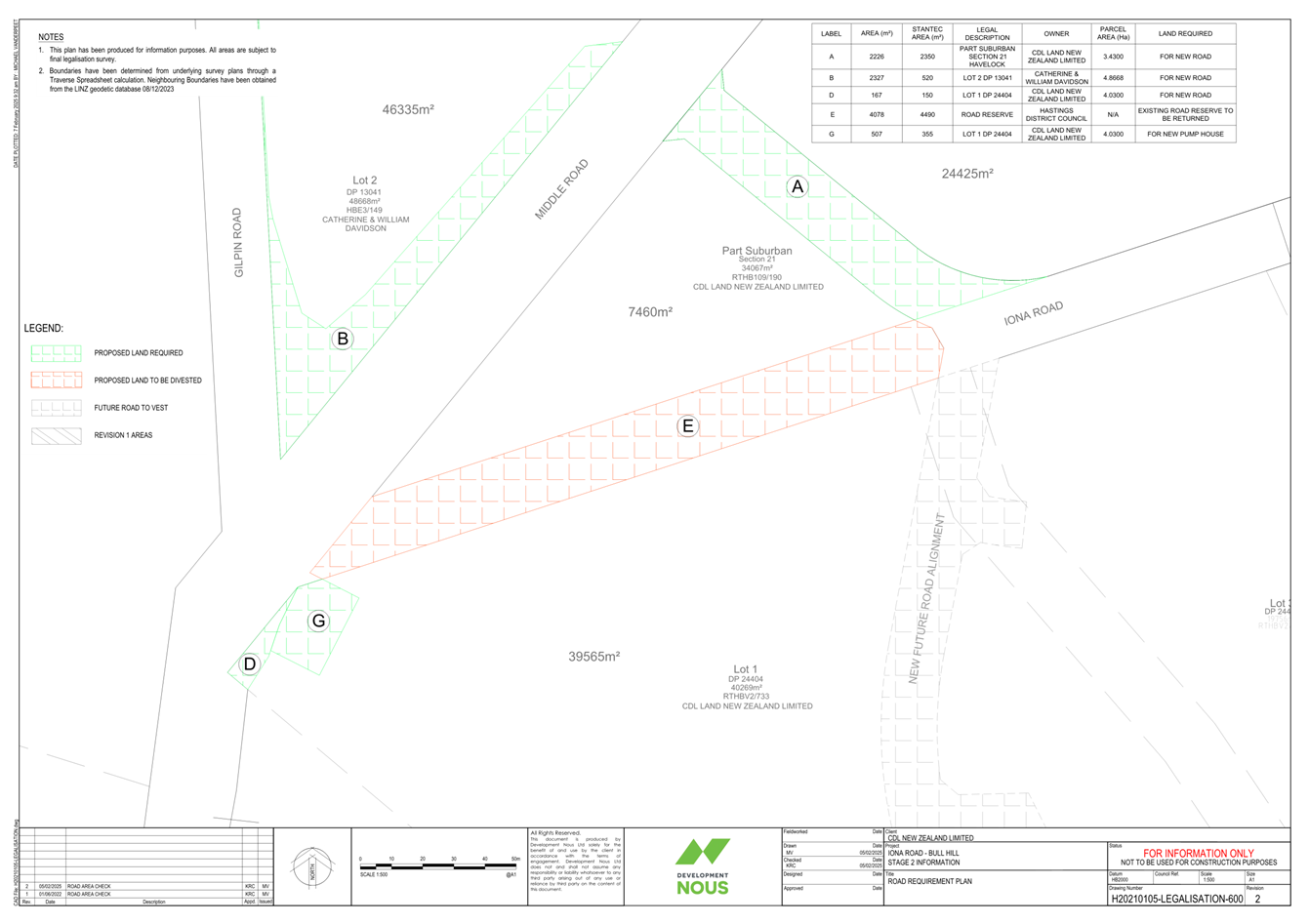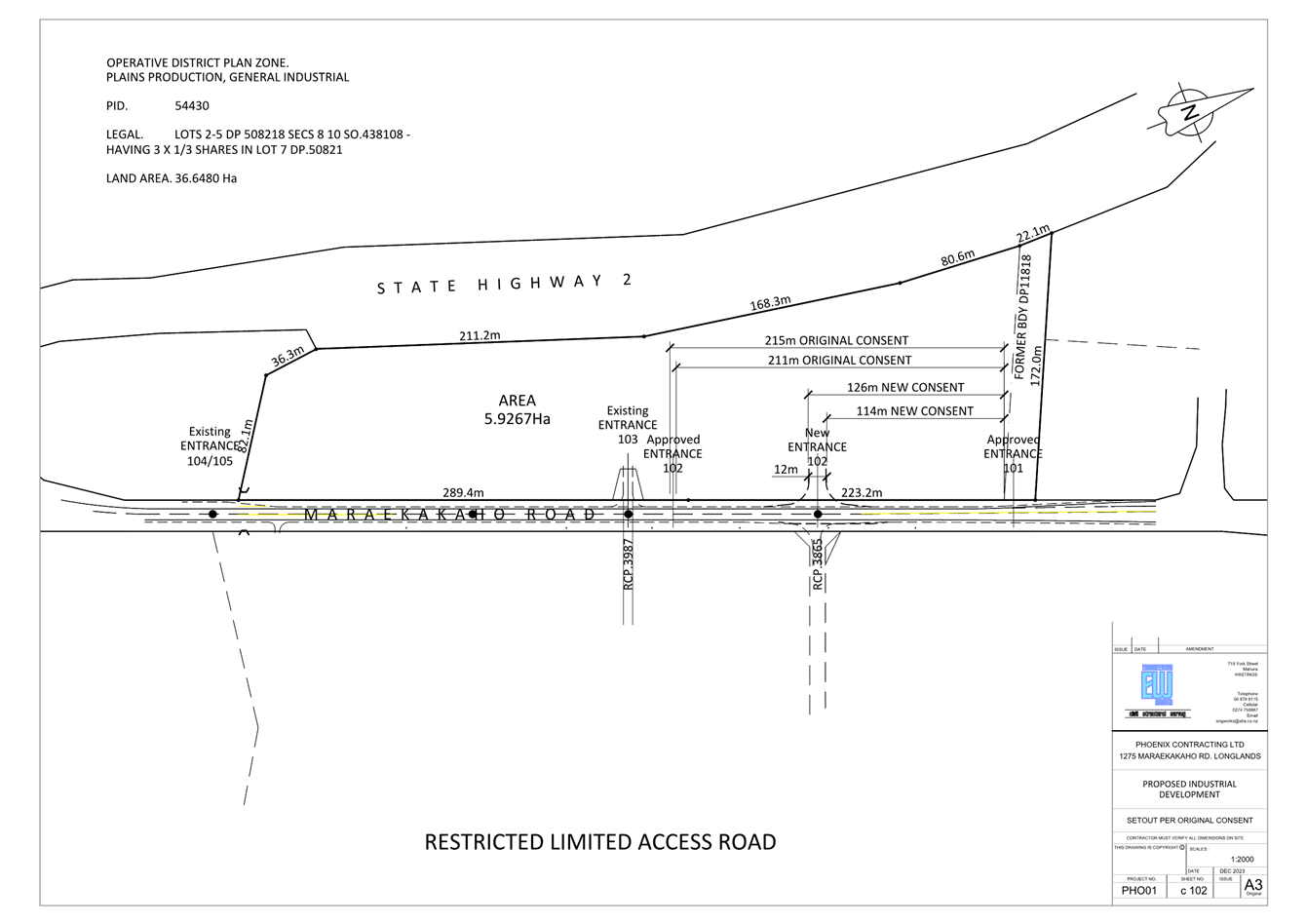Kaupapataka
Agenda
|
Te Rā Hui:
Meeting date:
|
Tuesday, 22 July 2025
|
|
Te Wā:
Time:
|
1.00pm
|
|
Te Wāhi:
Venue:
|
Council Chamber
Ground Floor
Civic Administration
Building
Lyndon Road East
Hastings
|
|
Te Hoapā:
Contact:
|
Democracy
and Governance Services
P: 06 871 5000
| E: democracy@hdc.govt.nz
|
|
Te Āpiha Matua:
Responsible Officer:
|
Chief Executive - Nigel Bickle
|
Kaupapataka
Agenda
|
Mematanga:
Membership:
|
Tiamana
Chair: Mayor Sandra Hazlehurst
Ngā KaiKaunihera
Councillors: Ana Apatu,
Marcus Buddo, Alwyn Corban, Malcolm Dixon, Michael Fowler, Damon Harvey, Henry
Heke, Kellie Jessup, Tania Kerr (Deputy Mayor), Hana Montaperto-Hendry, Simon
Nixon, Wendy Schollum, Heather Te Au-Skipworth and Kevin Watkins and one
councillor vacancy
|
|
Tokamatua:
Quorum:
|
8 members
|
|
Apiha Matua
Officer Responsible:
|
Chief Executive – Nigel
Bickle
|
|
Te Rōpū Manapori me te Kāwanatanga
Democracy and Governance Services:
|
Louise Stettner (Extn 5543)
|
Te Rārangi Take
Order of Business
|
1.0
|
Opening
Prayer – Karakia
Whakatūwheratanga
|
|
|
2.0
|
Apologies
& Leave of Absence – Ngā Whakapāhatanga me te Wehenga ā-Hui
At the
close of the agenda no apologies had been received.
Leave of Absence
had previously been granted to Councillor Kerr
|
|
|
3.0
|
Conflict
of Interest –
He Ngākau Kōnatunatu
Members need to be vigilant to stand aside from
decision-making when a conflict arises between their role as a Member of the
Council and any private or other external interest they might have.
This note is provided as a reminder to Members to scan the agenda and assess
their own private interests and identify where they may have a pecuniary or
other conflict of interest, or where there may be perceptions of conflict of
interest.
If a Member feels they do have a conflict of
interest, they should publicly declare that at the start of the relevant item
of business and withdraw from participating in the meeting. If a Member
thinks they may have a conflict of interest, they can seek advice from
the General Counsel or the Manager: Democracy and Governance (preferably
before the meeting).
It is noted that while Members can seek advice and
discuss these matters, the final decision as to whether a conflict exists
rests with the member.
|
|
|
4.0
|
Confirmation
of Minutes –
Te Whakamana i Ngā Miniti
Minutes of the
Council Meeting held Tuesday 17 June 2025.
(Previously circulated)
|
|
|
5.0
|
Uplift
of Agenda Item relating to the 'Napier Hastings Future Development Strategy'
resolved at the Council Meeting on 26 June 2025 to 'Lie On The Table'
|
7
|
|
6.0
|
Adoption
of the Napier/Hastings Future Development Strategy (as uplifted)
|
35
|
|
7.0
|
Road
Stopping of Part of Iona Road for the Iona Structure Plan
|
47
|
|
8.0
|
Authorisation
for relocation of a crossing place on a Limited Access Road to serve Lots 2-5
DP 508218 at 1275 Maraekakaho Road
|
55
|
|
9.0
|
Proposed
Amendments To Schedule Of Meetings
|
63
|
|
10.0
|
Submissions
on Proposed National Policy Statements and National Environmental Standards
Changes and on the Freshwater Discussion Document
|
65
|
|
11.0
|
Minor Items
– Ngā Take
Iti
|
|
|
12.0
|
Urgent
Items –
Ngā Take Whakahihiri
|
|
|
13.0
|
Recommendation
to Exclude the Public from Item 14
|
101
|
|
14.0
|
CON2020007
- 3 Waters Maintenance Contract
|
|

Te
Hui o Te Kaunihera ā-Rohe o Heretaunga
Hastings
District Council: Council Meeting
Te
Rārangi Take
Report to Council
|
Nā:
From:
|
Craig Cameron, Group
Manager: Democracy and Emergency Management
|
|
Te Take:
Subject:
|
Uplift of Agenda Item
relating to the 'Napier Hastings Future Development Strategy' resolved at the
Council Meeting on 26 June 2025 to 'Lie On The Table'
|
1.0 Executive
Summary –
Te Kaupapa Me Te Whakarāpopototanga
1.1 Agenda Item 8, for the Council Meeting on 26 June 2025,
related to ‘Adoption of the Napier/Hastings Future Development
Strategy’.
1.2 Council
resolved a ‘Procedural Motion’ in respect of this Agenda Item
(paragraph 1.1), that the ‘Item of business being discussed should lie on
the table and not be further discussed at the meeting’. This was in
accord with Council Standing Orders 25.2 (d).
1.3 In the Council
meeting, prior to the resolution of the Procedural Motion (paragraph 1.2),
Councillors requested information/advice from the Chief Executive regards;
· The
credibility of development on sites in Napier including Ahuriri Station and
Riverbend Road.
· Will a land
supply deficit in Hastings undermine the viability of the Napier Hastings
Future Development Strategy (FDS) as a whole.
1.4 Council
subsequently requested further information/advice from the Chief Executive
regards legal risks to Council, if Council makes decision/s contrary to the
recommendations of the Independent Panel established to hear submissions and
make recommendations to the Napier Hastings Future Development Strategy Joint
Committee on the draft FDS.
1.5 The
Chief Executive has commissioned two Reports for Council to address Councils
requests for information/advice on the Napier Hastings Future Development
Strategy (FDS), regarding;
· Technical
FDS matters. This Report has been prepared by Barker & Associates from
existing information appended to the Agenda Item. No new information is
considered.
· Legal
risks for Council arising from any Council decisions that are contrary to the
recommendations of the Independent Panel established to hear submissions and
make recommendations to the Napier Hastings Future Development Strategy Joint
Committee on the draft FDS. This Report has been prepared by Councils legal
advisers Simpson Grierson.
These two Reports
are attached as Attachment 1.
1.6 This
Administrative Report confirms the situation for Council from its meeting on 26
June 2025 and prepares Council for continuation of questioning of officers
& consultants & advisors (for clarification) then continuation of
deliberations in this Council Meeting in respect of the FDS Agenda Item 8
(paragraph 1.1). The draft minutes from Councils meeting on 26 June 2025 are
attached as Attachment 2.
1.7 Agenda
Item 8, for the Council Meeting on 26 June 2025, related to ‘Adoption of
the Napier/Hastings Future Development Strategy’ including attachments,
has been cloned/copied onto today’s meeting Agenda, for the convenience
of Council.
|
2.0 Recommendations - Ngā Tūtohunga
A) That Council receive the
report titled Uplift of Agenda Item relating to the 'Napier Hastings Future
Development Strategy' resolved at the Council Meeting on 26 June 2025 to 'Lie
On The Table' dated 22 July 2025.
B) That
Council note the Chief Executive has commissioned two Reports for Council to
address Councils requests for information/advice on the Napier Hastings
Future Development Strategy (FDS), regarding;
· Technical
FDS matters. This Report has been prepared by Barker & Associates from
existing information appended to the Agenda Item.
· Legal
risks for Council arising from any Council decisions that are contrary
to the recommendations of the Independent Panel established to hear
submissions and make recommendations to the Napier Hastings Future
Development Strategy Joint Committee on the draft FDS. This Report has been
prepared by Councils legal advisers Simpson Grierson.
These two Reports are attached as Attachment 1.
C) That Council uplift
Agenda Item 8 from its Council Meeting on 26 June 2025, which Council
resolved to ‘Item of business being discussed should lie on the table
and not be further discussed at the meeting’. This was in accord with
Council Standing Orders 25.2 (d).
D) That Council receive the
two Reports in Recommendation B as part of the resolution of Recommendation
C.
E) That Council notes
that subject to the resolution of Recommendation C, the substantive motion on
the table is;
Councillor
Buddo/Councillor Schollum
A) That Council receive the report titled Adoption of
the Napier/Hastings Future Development Strategy 26 June 2025.
B) That
Council notes the resolution of the Napier Hastings Future Development
Strategy Joint Committee (FDSJC) from its Committee Meeting on 19 May 2025 as
shown in the meeting minutes (Attachment 5). In particular resolution
B which recommended the endorsement of the IHP report with the exclusion of
Riverbend Road NC4b
C) That
Council notes this Agenda Report fulfils the Requirement of Resolution D
(Report for Partner Councils) of the FDSJC.
D) That
Council notes the draft final FDS (Attachment 1) does not include the
FDSJC Resolution (refer Recommendation B) to exclude NC4b Riverbend Road.
E) Notes
that the Partner Councils [HDC/NCC], in accordance with
Section 3.12 of the National Policy Statement on Urban Development 2020 which
relates to requirements local authorities to prepare and publish a Future
Development Strategy (FDS), accepts in part the recommendations of the FDSJC,
but with the inclusion of Riverbend Road NC4b., and
F) Adopts Approves a final FDS that includes Riverbend
Road NC4b with additional wording below relating to that specific site (to be
added to page 59, following the wording describing Ahuriri Station).
Riverbend (NC4b)
Riverbend (NC4b) has long been identified as a
potential location for future urban development, including through the
Heretaunga Plains Urban Development Strategy 2010 and 2017 editions. Active
planning work has been undertaken over recent years involving the landowner
and Napier City Council.
HBRC has expressed concerns about the potential for
development at Riverbend given the site’s susceptibility to flooding
risk and other natural hazards. There is well documented evidence of flooding
affecting the site (for example, recent events in November 2020 and February
2023). The low-lying topography means the site is vulnerable to runoff and
flooding, including from the existing neighbouring residential area.
Significant site-specific engineering works would be
required to manage stormwater and flooding effects arising from development
at Riverbend, including to maintain important environmental values to an
acceptable level. Additional land will be required to manage these effects
outside of the existing identified NC4b area if mitigation works cannot be
achieved onsite. This is acknowledged in a footnote to Table 3 of the FDS.
The inclusion of Riverbend NC4b in the FDS does not
predetermine the outcome of subsequent planning process, including structure
planning, plan changes, and resource consent applications.
As part of any application for consent or rezoning
proposal to develop the Riverbend NC4b site, further detailed work will need
to be undertaken to ensure the site’s suitability for development and
necessary mitigation of stormwater and flooding impacts. This should include
consideration of ‘residual risks’ (i.e. circumstances where
events may exceed design and construction capacity of stormwater mitigation
works) as has been recommended in the 2024 Hawke’s Bay Independent
Flood Review Panel’s report.
G) That
Council notes that if the adopted draft final FDS aligns with F, then
consequential amendments will be required to be made to Attachment 1
to include the additional wording.
H) Notes
the decision made by Hawke’s Bay Regional Council on 25 June 2025 to
adopt a FDS which excludes the following sites identified by the Hearings
Panel as New Residential Greenfield Development Areas: Riverbend Road NC4b
and Middle Road Hn3a and Hn3b.
I) Directs
staff to work with [HDC/NCC] and Hawke’s Bay Regional Council staff to
prepare a joint FDS which takes into account the decisions made by all
Partner Councils, and then report back with a final joint FDS that can be
adopted by the Partner Councils and published in accordance with clause 3.12
of the National Policy Statement on Urban Development 2020.
J) Recommendations
A) to I) as they stand with the removal of Middle Road HN3A and HN3B and Wall
Road H5 from the FDS.
|
3.0 Background – Te Horopaki
3.1 The
draft Meeting Minutes, relating to the FDS Agenda Item (paragraph 1.1) are
attached to this Report (as Attachment 2). The Meeting Minutes are draft
as they are yet to be considered/approved by Council.
3.2 Regards
Agenda Item 8 / FDS Agenda Item (paragraph 1.1);
· A Motion was moved
and seconded for paragraphs ‘A to I’ in Attachment 2 and became the
substantive motion on the table.
· An Amendment was
moved and seconded for paragraph ‘J’ in Attachment 2.
· The Amendment was
debated, and the Chair put the Amendment.
· The Amendment was
carried (7 – 6). This Amendment to the original motion was added to the
substantive motion on the table.
· Mr Cameron advised
the Chair that members may wish to record their reasons for making an Amendment
that is contrary to the ‘Independent Panels’ advice. Mr Cameron
gave this advice to the Chair to help ensure transparency in the decision-making
process.
· The Chair
adjourned this Agenda Item within the Meeting to progress with other Agenda
Items whilst officers understood and drafted reasons for the amendment and
prepared further information for clarity on development capacity
issues.
· Council has not
yet considered reasons for its resolved Amendment.
· The Chair
reconvened the Agenda Item in the Meeting. The Substantive Motion was now
paragraphs A-J in Attachment 2. The Meeting was ready to debate the new
substantive motion and/or potentially receive additional amendments.
· Council debated
and resolved a ‘Procedural Motion’ in respect of this Agenda Item,
that the ‘Item of business being discussed should lie on the table and
not be further discussed at the meeting’. This is in accord with Council
Standing Orders 25.2 (d).
4.0 Discussion – Te Matapakitanga
4.1 In
the Council meeting, prior to the resolution of the Procedural Motion (in 1.2),
Councillors requested information/advice from the Chief Executive regards;
· The
credibility of development on sites in Napier including Ahuriri Station and
Riverbend Road.
· Will a land
supply deficit in Hastings undermine the viability of the Napier Hastings
Future Development Strategy (FDS) as a whole.
4.2 Council
have subsequently requested further information/advice from the Chief Executive
regards legal risks to Council, if Council makes decision/s contrary to the
recommendations of the Independent Panel established to hear submissions and
make recommendations to the Napier Hastings Future Development Strategy Joint
Committee on the draft FDS.
4.3 The
Chief Executive has commissioned two Reports for Council to address Councils
requests for information/advice on the Napier Hastings Future Development
Strategy (FDS), regarding;
· Technical
FDS matters. This Report has been prepared by Barker & Associates from
existing information appended to the Agenda Item. No new information is
considered.
· Legal
risks for Council arising from any Council decisions that are contrary to
the recommendations of the Independent Panel established to hear submissions
and make recommendations to the Napier Hastings Future Development Strategy
Joint Committee on the draft FDS. This Report has been prepared by Councils
legal advisers Simpson Grierson.
These two Reports
are attached as Attachment 1.
4.4 Regards
procedures for Today’s Meeting, - subject to Council resolving the
recommendations in this Report and uplifting the Agenda Item that was left to
lie on the table, it is recommended Council;
· Seek any
clarification needed regards the two Reports discussed in 4.3 and received by
Council resolving Recommendation D.
· Resume
consideration of the Substantive Motion on the Table (Clauses A-J) in the
draft Meeting Minutes attached as Attachment 2.
4.5 Agenda
Item 8, for the Council Meeting on 26 June 2025, related to ‘Adoption of
the Napier/Hastings Future Development Strategy’ including attachments,
has been cloned/copied onto today’s meeting Agenda, for the convenience
of Council.
5.0 Options – Ngā Kōwhiringa
Option One - Recommended Option -
Te Kōwhiringa Tuatahi – Te Kōwhiringa Tūtohunga
5.1 This
Report is an administrative report, to assist the Council meeting by confirming
the circumstances arising from the previous Council meeting on 26 June 2025,
where Council resolved a ‘Procedural Motion’ in respect of the
Agenda Item relating to the FDS, that the ‘Item of business being
discussed should lie on the table and not be further discussed at the
meeting’. This was in accord with Council Standing Orders 25.2
(d).
5.2 No
advantages are noted for Council not resolving the Recommendations in this
Report and continuing with deliberations on the Agenda Item regarding the
Napier Hastings Future Development Strategy.
Attachments:
|
1⇩
|
Attachment 1 - Reports from Barkers and Associates and
Simpson Grierson 2025-07-16
|
CG-17-1-01683
|
|
|
2⇩
|
Attachment 2 - DRAFT FDS Council Resolutions - 26 June
2025
|
CG-17-1-01677
|
|
|
Item 5 Uplift
of Agenda Item relating to the 'Napier Hastings Future Development Strategy'
resolved at the Council Meeting on 26 June 2025 to 'Lie On The Table'
|
|
Attachment
1 - Reports from Barkers and Associates and Simpson Grierson 2025-07-16
|
Attachment 1
|














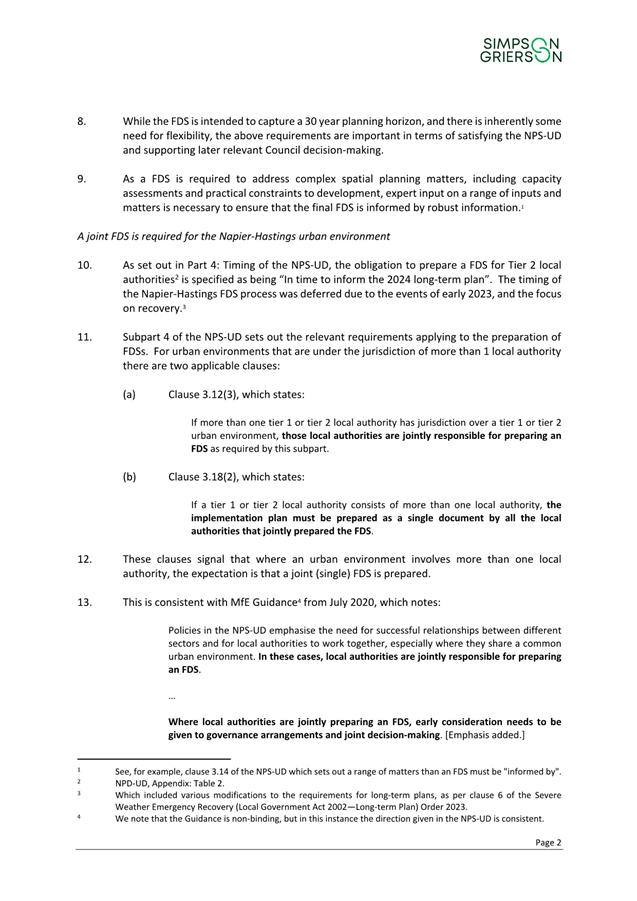
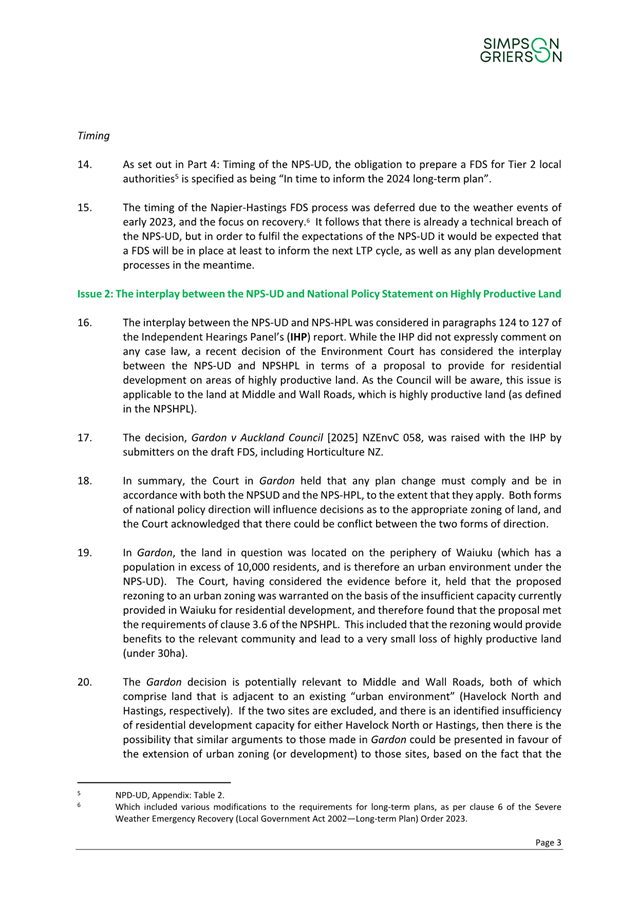
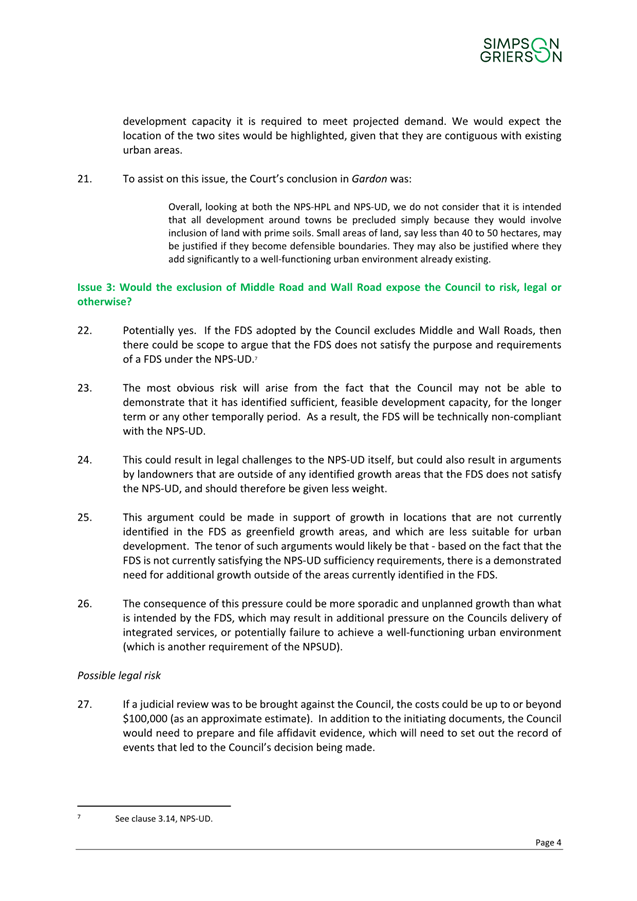
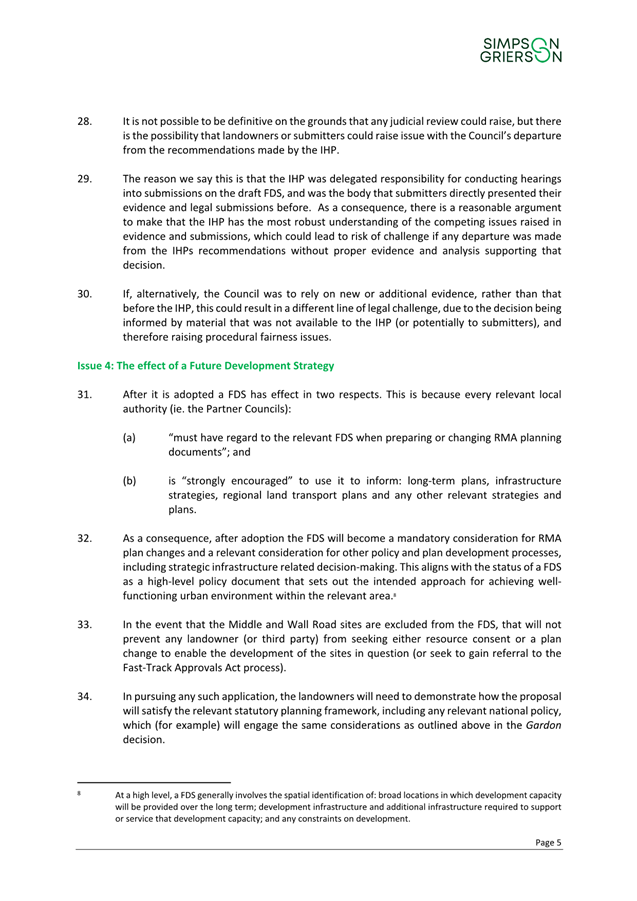
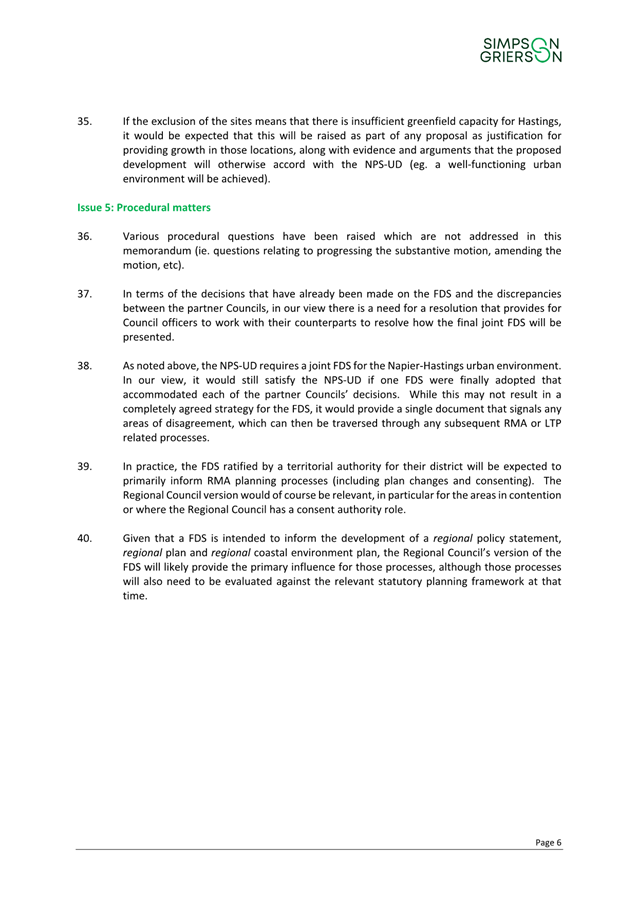
|
Item 5 Uplift
of Agenda Item relating to the 'Napier Hastings Future Development Strategy'
resolved at the Council Meeting on 26 June 2025 to 'Lie On The Table'
|
|
Attachment
2 - DRAFT FDS Council Resolutions - 26 June 2025
|
Attachment 2
|
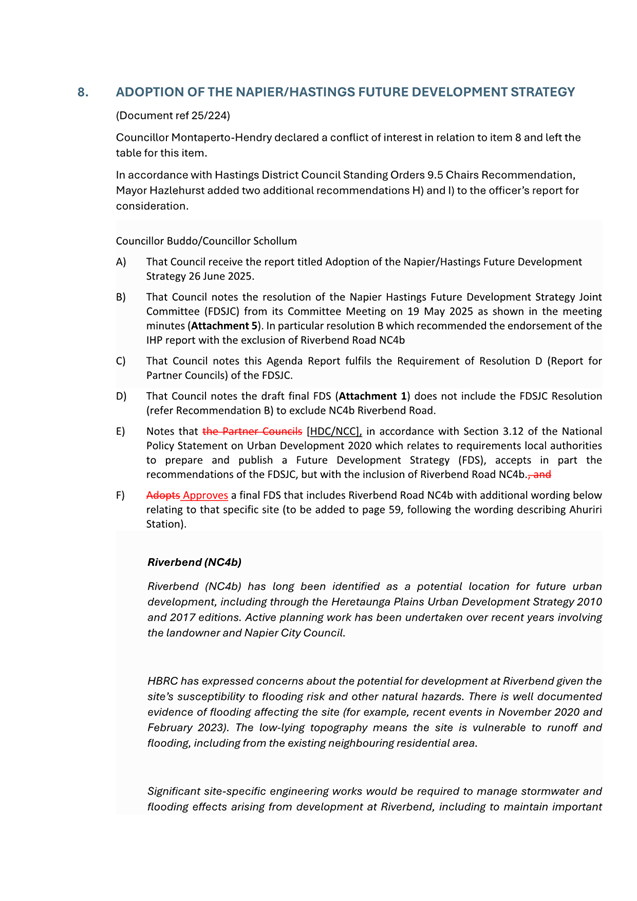
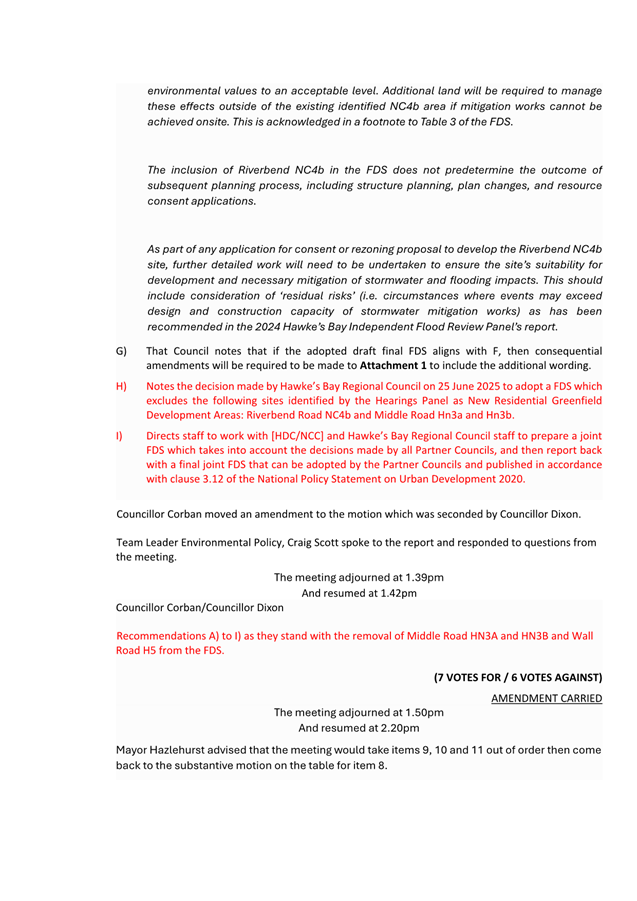


Hastings
District Council: Council Meeting
Te Rārangi Take
Report to Council
|
Nā:
From:
|
Nigel Bickle, Chief
Executive
|
|
Te Take:
Subject:
|
Adoption of the
Napier/Hastings Future Development Strategy (as uplifted)
|
1.0 Executive Summary
– Te Kaupapa Me Te
Whakarāpopototanga
1.1 The
purpose of this report is to inform the adoption of a final joint Future
Development Strategy (FDS) for the Napier-Hastings urban environment, which
satisfies section 3.12 of the National Policy Statement on Urban Development
(NPSUD).
1.2 The
background context to the development of the FDS is set out in this report, and
other reports presented to the Future Development Strategy Joint Committee
(FDSJC) established by the Partner Councils. Of note, the FDSJC approved
the draft FDS for notification on 23 October 2024 and then appointed an
Independent Hearings Panel (IHP) to hold hearings and consider submissions on
the draft FDS. Following those hearings, the FDSJC met on 19 May 2025 to
consider the recommendations made by the IHP.
1.3 The
FDSJC adopted the IHP’s recommendations for all but one site (Riverbend
Road – NC4b), with the draft FDS recommended for approval by the IHP
attached as Attachment 1. For clarity, note that an amended version of
the draft FDS was not provided following the FDSJC recommendations.
1.4 Subject
to the consideration of this recommendation report by the Partner Councils,
Officers consider that the draft FDS will satisfy the statutory requirements
for a Future Development Strategy under the NPSUD.
1.5 This
Report fulfils the Requirement of Resolution D (Report for Partner Councils) of
the FDSJC, which required that a recommendation report be prepared to inform
decision-making by the Partner Councils. This Report sets out the
background context, statutory requirements and considerations, and makes a
recommendation on the final form of the FDS for the Napier-Hastings urban
environment.
|
2.0 Recommendations -
Ngā Tūtohunga
A) That Council receive the report titled Adoption of the
Napier/Hastings Future Development Strategy (as uplifted) dated 22 July 2025.
B) That
Council notes the resolution of the Napier Hastings Future Development
Strategy Joint Committee (FDSJC) from its Committee Meeting on 19 May 2025 as
shown in the meeting minutes (Attachment 5). In particular resolution
B which recommended the endorsement of the IHP report with the exclusion of
Riverbend Road NC4b
C) That
Council notes this Agenda Report fulfils the Requirement of Resolution D
(Report for Partner Councils) of the FDSJC.
D) That Council
notes the draft final FDS (Attachment 1) does not include the FDSJC
Resolution (refer Recommendation B) to exclude NC4b Riverbend Road.
E) That
the Partner Councils in accordance with Section 3.12 of the National Policy
Statement on Urban Development 2020 which relates to requirements local
authorities to prepare and publish a Future Development Strategy (FDS),
accept in part the recommendations of the FDSJC, but with the inclusion of
Riverbend Road NC4b, and
F) That
Council adopt a final FDS that includes Riverbend Road NC4b with additional
wording below relating to that specific site. (to be added to page 59,
following the wording describing Ahuriri Station).
Riverbend (NC4b)
Riverbend (NC4b) has long been identified as a
potential location for future urban development, including through the
Heretaunga Plains Urban Development Strategy 2010 and 2017 editions. Active
planning work has been undertaken over recent years involving the landowner
and Napier City Council.
HBRC has expressed concerns about the potential for
development at Riverbend given the site’s susceptibility to flooding
risk and other natural hazards. There is well documented evidence of flooding
affecting the site (for example, recent events in November 2020 and February
2023). The low-lying topography means the site is vulnerable to runoff and
flooding, including from the existing neighbouring residential area.
Significant site-specific engineering works would be
required to manage stormwater and flooding effects arising from development
at Riverbend, including to maintain important environmental values to an
acceptable level. Additional land will be required to manage these effects
outside of the existing identified NC4b area if mitigation works cannot be
achieved onsite. This is acknowledged in a footnote to Table 3 of the FDS.
The inclusion of Riverbend NC4b in the FDS does not
predetermine the outcome of subsequent planning process, including structure
planning, plan changes, and resource consent applications.
As part of any application for consent or rezoning
proposal to develop the Riverbend NC4b site, further detailed work will need
to be undertaken to ensure the site’s suitability for development and
necessary mitigation of stormwater and flooding impacts. This should include
consideration of ‘residual risks’ (i.e. circumstances where
events may exceed design and construction capacity of stormwater mitigation
works) as has been recommended in the 2024 Hawke’s Bay Independent
Flood Review Panel’s report.
G) That
Council notes that if the adopted draft final FDS aligns with F, then
consequential amendments will be required to be made to Attachment 1
to include the additional wording.
|
3.0 Statutory
Context for FDS
3.1 The
NPSUD requires all tier 1 and tier 2 local authorities (Council is a tier 2
authority) to review every 3 years and to make publicly available an FDS for
the urban environment every 6 years and in time to inform or at the same time
as preparation of the next Long-Term Plan of each relevant local authority.
Where an urban environment involves more than one local authority, the NPSUD
requires that a FDS is prepared jointly.
3.2 The
NPS-UD states that the purpose of an FDS is to promote long term strategic
planning by setting out how the Partner Councils (Hastings District Council,
Napier City Council, Hawke’s Bay Regional Council) intend to:
· Achieve
well-functioning urban environments in existing and future urban
areas,
· Provide at least
sufficient development capacity over the next 30 years to meet expected demand,
and
· Assist with the
integration of planning decisions under the Resource Management Act with
infrastructure planning and funding decisions.
3.3 A
FDS is a strategic document that is intended to assist the Partner Councils
with integrating planning decisions under the Resource Management Act 1991
(RMA) with Council Long Term Plans, Infrastructure Strategies, and funding
decisions under the Local Government Act 2002 (LGA).
3.4 Development
of the FDS has been ongoing for several years and has included lengthy engagement
with mana whenua, elected officials, the community, interested landowners and
developers, to inform detailed technical analysis and evaluation.
3.5 The
FDS has been jointly developed in partnership with Hastings District Council,
Napier City Council, Hawke’s Bay Regional Council, and has directly
involved Maungaharuru Tangitū Trust, Mana Ahuriri Trust and Tamatea
Pōkai Whenua, all of which had members on the FDSJC.
3.6 In
addition, significant input has been received from council officers,
consultants and interested individuals, groups and stakeholders. This included:
· Barker &
Associates, which is a specialist planning consultancy
· staff from
Maungaharuru Tangitū Trust
· staff from Mana
Ahuriri Trust and
· staff from Tamatea
Pōkai Whenua.
3.7 The
draft FDS was adopted by the FDSJC for consultation and is intended (once
adopted) to satisfy the statutory requirements for Future Development
Strategies under the NPSUD.
3.8 Once
adopted, the final FDS will replace the current Heretaunga Plains Urban
Development Strategy 2017 (HPUDS).
4.0 Consultation and
Engagement
4.1 Section
3.15 of the NPSUD requires local authorities when preparing or updating an FDS
to use the special consultative procedure in Section 83 of the Local Government
Act 2002.
4.2 On October 23, the
FDSJC recommended to the partner councils, (Hastings District Council, Napier
City Council and Hawke’s Bay Regional Council,) that the Draft Napier
Hastings Future Development Strategy (FDS) be adopted for public notification
and submission. One variation to the draft was put forward by the FDSJC
Middle Rd
The
recommendation of the committee included one amendment to the strategy proposed
by the consultants and technical advisory group. This was the exclusion of
Middle Road sites Hn3a and Hn3b from the strategy. For the following reasons:
• These
areas are not required to provide sufficient development capacity to meet
demand (including the 20 per cent competitiveness margin)
• Hn3a and
Hn3b are Highly Productive land areas (including ‘Land Use
Capability’ level 1 and 2)
• These
areas are not included in the Heretaunga Plains Urban Development Strategy
(except as a reserve area in the case of Hn3a)
• It would
be contrary to the objectives of the FDS to include these areas.
The draft
recommendations were then considered by all Partner Councils in November. All
Councils agreed to accept the Joint Committee’s amendment to remove the
Middle Rd sites Hn3a and Hn3b from the draft strategy. Those two sites have
subsequently been removed from the draft.
4.3 An additional
amendment to the draft was recommended by Hawke’s Bay Regional Council
being the removal of Riverbend Road NC4b. The Hastings District Council and
Napier City Council voted to retain this area. To address this, the partner
councils agreed that the strategy be notified for public input, with this
divergence noted via this covering note, and that the divergence will be
considered by the independent panel to be appointed to hear submissions.
Riverbend Rd
The
Hawke’s Bay Regional Council additionally recommended that the Riverbend
Road site Nc4b also be excluded from the strategy, for the following reason:
•
Area Nc4b is subject to severe flooding risk.
4.4 The
FDSJC also resolved at its meeting held on 23 October 2024 to;
‘Appoint an Independent Panel to assist the Joint
Committee by hearing all persons / parties who wish to submit on the draft FDS.
The Independent Panel will prepare a summation of all submissions and provide
recommendations to the Joint Committee, for consideration by the Joint
Committee. The Joint Committee can then recommend a final FDS to the Partner
Councils’
4.5 The draft FDS was
adopted by the Partner Councils for consultation on the 19th
November 2024.
4.6 The
Independent Hearings Panel (IHP) consisted of the following members:
· Gina
Sweetman (Chair),
Field of Expertise - Resource management, local and
regional planning, policy and plan development. Resource consents. Te Ao Maori,
Freshwater and Chair of Hearing Panels.
· Shadrach
Rolleston,
Field of
Expertise - Planning and Resource Management, Spatial and Growth Management
Planning, Community and Māori Engagement, Te Ao Māori, Iwi Management
Planning, Tikanga Māori, Treaty Settlements, Local Government Policy
Planning.
· Juliane
Chetham,
Field of
Expertise - Planning, environmental science, geography, coastal and marine
ecology and management, Cultural Impact Assessment, Tikanga Māori,
Mātauranga Māori.
· Michael
Parsonson,
Field of
Expertise - District and regional consenting, plan changes, policy development.
Resource use, construction, infrastructure, general land use activities, and
associated effects. Council hearings, fast-track panels, boards of inquiry.
· Steven
(Tipene) Wilson
Field of
Expertise – Māori, Iwi
4.7 The notification
period for the draft FDS ran from 23rd November 2024 to the 23rd
December 2024. This period was chosen to avoid the summer break and much of
January when many workplaces are closed and staff are away for significant
periods of time and therefore may not have had sufficient opportunity to
prepare a submission.
4.8 A
total of 139 submissions were received on the draft FDS. These included a combination
of online survey submissions and general submissions. The submissions were
evaluated by officers from partner Councils and PSGEs. A Recommendations Report
was prepared for the IHP in advance of the hearings commencing. The officers’
Recommendations Report is attached as Attachment 3 (FDS-Hearings-Report-2025-03-17-1.pdf).
4.9 At
the invitation of the IHP, all submitters were also able to provide additional
evidence to help accompany presentations at subsequent Public Hearings.
4.10 The
process adopted by the IHP provided submitters with the opportunity to
critique, assess, support or otherwise any aspects of the draft FDS.
4.11 Submissions
were heard by the IHP during 24 – 26 March 2025. 86 of the lodged
submissions were spoken to at the hearings. Following the hearings the IHP
requested that officers provide a Reply Report to consider additional evidence
presented to the IHP during the hearings. The officers’ Reply Report is
attached as Attachment 4 (Napier-Hastings-FDS-Reply-2025-04-04.pdf).
4.12 The
IHP was not required to accept the recommendations in the reply report.
4.13 In
executing their role, the IHP was required to consider all information received
from submitters (and their representatives), all supplementary information,
officers’ reports and verbal hearing information. This information
informed the IHP Recommendations Report.
5.0 IHP Findings and
Recommendations
5.1 The
IHP provided their Recommendation Report on 9th May 2025. The IHP
Recommendation Report attached as Attachment 2 was prepared by the
IHP and is independent from either officer or submitter input, albeit that the
IHP was informed by information provided by officers, submitters and the
various experts and other persons involved in the process.
5.2 The
Executive Summary from the IHP Recommendation Report is noted below:
1. Having
considered the submissions received, the Independent Hearings Panel (IHP or
Hearings Panel) has recommended several changes to the draft FDS. Most of those
changes were recommended to us by the professional experts and advisors
representing Napier City Council, Hastings District Council and the
Hawke’s Bay Regional Council and Tamatea Pōkai Whenua (TPW), Mana
Ahuriri Trust (MAT) and Maungaharuru-Tangitū Trust (MTT) (FDS Advisors).
2. Our
more substantive recommended changes to the draft FDS include:
a. A new section 4.3 on cross-boundary
relationships
b. References to the Hawke’s Bay
Independent Flood Review Report recommendations in respect to natural hazard
data collection and Regional Policy Statement and district plan reviews
c. Amendments to Section 6 to address
redress land and papakāinga
d. Amendment to the strategic objectives to amend
objective 10 and include a new objective relating to nationally and regionally
significant infrastructure
e. Reference to latent demand and that there may
be a shortfall in wet industry in the long term in section 8
f. Amend the constraints identified in
Figure 13 to include areas for the safe operation and functional needs of
nationally and regionally significant infrastructure
g. Amend section 10 to address that growth area
boundaries shown in the FDS are indicative only and why small sites have not
been included
h. Amend table 2 in section 10 to include the
additional capacity identified for the Hastings District
i. Inclusion of Middle Road (HN3a and
HN3b), Wall Road (HN3b) and FM9 Portsmouth Road, Flaxmere as new Residential
Greenfield Development Areas in Table 3, and include the additional land at the
Mission Estate
j. Include Irongate North as a new
industrial area in section 10
k. Include reference in section 10 about a
potential shortfall in development capacity for wet industry and the approach
to be taken if this eventuates
l. Amend 10.6 to reference a
carry-over of the strategic direction for coastal and rural settlements from
HPUDS in an appendix, including maps, until such time as a Rural Residential
Strategy is promulgated
m. New paragraph in section 10.11 to reference the
importance of the operational and functional needs of nationally and regionally
significant infrastructure,
n. Amend section 10.11 to say that stormwater
solutions may occur out of identified growth areas and reference specific
Māori education demands
o. Include new sections in 10.11 on solid waste
and nationally and regionally significant infrastructure
p. Amend table 6 to reference additional
greenfield capacity and remove reference to an “overs/unders”
approach.
3. Other
than for the matters listed above, no substantial changes to any
‘spatial’ components of the FDS are recommended.
4. Our
recommendations are to be considered and decided on by the Future Development
Strategy Joint Committee.
5.3 In
terms of spatial components, the key decisions and changes recommended to the
draft FDS that was formally consulted on for submissions are as follows:
Residential
· Inclusion
of HN3a and HN3b (Middle Road) area. (Long Term Priority 11 – 30+ years)
· Inclusion
of H5b (Wall Rd) area. (Long Term Priority 11 – 30+ years)
· Inclusion
of FM9 (Portsmouth Rd) area. (Long Term Priority 11 – 30+ years)
· Inclusion
of additional land at NC6 (Mission Hills). (Medium to Long Term Priority (5
– 30 years)
Industrial
· Inclusion
of IR4 (Irongate North) area (Long Term Priority 11 – 30+ years).
· Recognition
that wet industry capacity will be needed over the long term. Recommending
short-term action to investigate policy changes aimed at protecting the
remaining capacity within the existing urban area for wet industry use at
Whakatu.
Rural Residential
· Recommendation
for councils to prioritise the development of a Rural Residential Strategy.
6.0 IHP Commentary regarding Riverbend Road
6.1 As part of their
recommendation’s report, the IHP specifically addressed a number of the
more contentious areas. Following the FDSJC recommendations with regard to
Riverbend Road NC4b, it is relevant to include extracts of the IHP’s
reasoning for their recommendations. The Riverbend Road discussion can be found
from paragraphs 54 to 66 of the IHP Recommendations Report (Attachment 2).
6.2 The IHP recognised
that there are significant constraints on the Riverbend site, acknowledging
that it currently acts as a basin for stormwater detention area for surrounding
land for the surrounding area
Riverbend is a
residential growth area in the Heretaunga Plains Urban Development Strategy
(HPUDS) and meets the definition of being “identified for urban
development.”10 The draft FDS identifies the area as a suitable specific
growth area, acknowledging that the area is subject to complex and overlapping
natural hazards constraints. While there are engineering solutions available to
address these constraints, they may impact the feasibility and timing of
development
6.3 The IHP also
recognised that the existing condition of the land in question, and the
relevant concerns of HBRC given the flooding of the site during significant
rain events in 2020 and 2023, with the site providing significant storage
adjacent to existing residential areas.
Stormwater
engineering evidence was presented on behalf of the Joint Venture by Ms Landon
of Development Nous Limited. Ms Landon acknowledged that the site currently
functions as an “unofficial” stormwater detention area for the
surrounding urban areas. She described the likely approach to flood mitigation
for development of the site, which included flood storage and pumping, and
conservatism in her assumptions. This is subject to ongoing analysis and design
and will require detailed interrogation through a resource consent process.
6.4 The IHP ultimately
acknowledged that the suitability of development should be assessed through a
more detailed plan change or resource consent process where the specific
constraints of the site and feasibility of development can be properly
understood. The IHP ultimately recommend the inclusion of the site as a long
term priority:
For the reasons
outlined above, we accept and adopt the recommendation of the FDS
Advisors’ Hearing Report to include Riverbend site NC4b in the FDS, at
the timing recommended by the FDS Advisors. Ultimately, its suitability for
development will be managed through the more granular plan change and resource
consent processes. Its planning history and the consequential investment in
development planning weighs in favour of its inclusion.
6.5 It is noted that to
address these qualifications, a footnote was added to Table 3 of the
recommended FDS (pg 65) noting ‘Additional land will be required to
manage stormwater and flooding effects arising from development of Riverbend
Road (NC4b), with the exact location to be determined through future planning
processes.’
6.6 The IHP
recommendations report also specifically addresses submitters concerns with
regards to natural hazards, with specific mention of flooding. This is
addressed from paragraphs 48 to 53 of the report. Ultimately the IHP concluded
(noting the exceptions discussed relate to Riverbend Road and Ahuriri Station):
We accept there
are site-specific opportunities to mitigate some risks but, consistent with the
FDS Advisors’ Hearing Report, we limit inclusion of sites with identified
significant (before mitigation) natural hazard risk to the sites discussed below
that are subject to other relevant factors that support their inclusion. We
agree with the FDS Advisors’ Hearing Report in its response to the
Natural Hazards Commission and the Hawke’s Bay District Health Board
submissions, that site specific risk assessments for those future growth areas
are most appropriately undertaken “at the structure planning and plan
change [and resource consent] stage, where a detailed stormwater and flood
modelling can be undertaken in the context of a specific proposal”.
6.7 The submitter
information and evidence can be viewed on the FDS website https://www.hastingsdc.govt.nz/hastingsnapierfuturedevelopment/
under the submissions documents tab, evidence and supplementary evidence tabs.
The primary submissions related to Riverbend Road were (Sub 105 – Te
Orokohanga Hou Joint Venture, Sub 74 – Natural Hazards Commission, Sub 90
– HBRC, Sub 16 – John Reid, Sub 26 – Myriam Parker, Sub 34
– Gary Curtis, Sub 47 – Andrew Lessels, Sub 52 – Simon Nash,
Sub 8 – Samantha McPherson, Sub 9 – Susan Gardner & Sub 12
Forest and Bird, Sub 94 MTT), however noting that there are also a number
of submissions that related to natural hazards and flooding in general.
7.0 FDSJC Resolutions
7.1 The
‘FDSJC Meeting Minutes’ from their Meeting on 19 May 2025 are
attached as Attachment 5 (Minutes
of Napier-Hastings Future Development Strategy Joint Committee - Monday, 19 May
2025).
7.2 Two
motions were put forward for amendments by FDSJC members.
Exclude Middle
Road (HN3a and HN3b) and Wall Road (H5b)
7.3 With
the reasons for these exclusions being the sites in i) and ii) are on highly
productive land and are not required to meet demand capacity under the Future
Development Strategy.
7.4 This
amendment was lost (3 votes for/5 votes against/3 abstained).
7.5 The
Middle Road areas (HN3a and HN3b) added 640 dwellings and the Wall Road area
(H5b) added 110 dwellings to overall development capacity.
Exclude
Riverbend Road (NC4b)
7.6 With
the reasons for this exclusion being the site presents as a significant
flooding risk and is not conducive to a well-functioning urban environment and
is not required to meet demand capacity under the Future Development Strategy.
7.7 This amendment was
carried (8 votes for/3 votes against).
7.8 The
Riverbend Road NC4b land provided an estimated 660 dwellings to the overall
development capacity.
7.9 The
FDSJC recommendations will be put to all Partner Councils to consider when
determining the final FDS with the risks associated with each option discussed in
section 8 below. Dates for the respective Partner Councils’ meetings are:
· Hawke’s Bay
Regional Council – Wednesday 25th June 2025
· Hastings
District Council - Thursday 26th June 2025
· Napier
City Council – Thursday 26th June 2025.
8.0 Options – Ngā Kōwhiringa
Option
One - Recommended Option - Te Kōwhiringa Tuatahi – Te
Kōwhiringa Tūtohunga
8.1 Adopt
the Future Development Strategy as recommend by the FDSJC, except for in
relation to the exclusion of Riverbend Road NC4b, by adopting a final FDS that
includes Riverbend Road with associated additional wording included in the FDS
relating to that land. The recommended additional wording is included in Attachment
6 to this report.
Advantages
· Allows Partner
Councils to consider specific viewpoints of FDSJC when making decisions on the
final FDS.
· Ensures that a FDS
that is consistent with IHP recommendations is adopted, with appropriate
qualifying statements where development concerns remain (as expressed by the
FDSJC minutes and in IHP’s commentary within its own report).
· Qualifying
statements can reflect many of the IHP’s observations without undermining
or being a substantive departure from the IHP’s overall findings and
recommendations.
· Satisfies NPS-UD
requirements.
· Ensures that
future plan change or resource consent processes are fully informed of the
constraints that will need to be addressed around hazard mitigations.
Disadvantages
· May lead to future
contention in relation to proposals for the development of the land for
residential growth.
· Amendments to the
recommendations that differ from the IHP’s reporting could give rise to judicial
review proceedings.
· Amendments to the
recommendations that differ from the FDSJC’s resolutions could give rise
to judicial review proceedings, albeit for different grounds than a departure
from the IHP’s reporting above.
· If heavily
qualified statements are included and/or statements that are beyond factual
ones, it may mean that Riverbend Road NC4b is out of step with other sites
subject to constraints, noting that the recommended FDS includes qualifying
language in regard to future growth areas requirements under future RMA
processes.
Option
Two
8.2 Adopt
the Future Development Strategy as recommended by the IHP.
Advantages
· Would
be consistent with the evidence-based assessment undertaken by independent
qualified experts who directly heard from submitters during the hearing process.
· Meets the
obligations of the Partner Councils under the National Policy Statement –
Urban Development 2020 which requires that a Future Development Strategy is
prepared for the Napier/Hastings urban environment.
· If adopted by the Partner
Councils, the Future Development Strategy will provide increased certainty for
the future planned growth of the Napier/Hastings urban environment and assist
to identify other opportunities for future growth in the longer-term.
Disadvantages
· Does not align
with FDSJC recommendations regarding Riverbend Road.
Option Three
8.3 Adopt
the Future Development Strategy as recommended by the FDSJC.
Advantages
· Would be
consistent with the evidence-based assessment undertaken by independent
qualified experts who directly heard from submitters during the hearing process,
with the exception of Riverbend Road.
· Meets the
obligations of the Partner Councils under the National Policy Statement –
Urban Development 2020 which requires that a Future Development Strategy is
prepared for the Napier/Hastings urban environment.
· If adopted by the Partner
Councils, the Future Development Strategy will provide increased certainty for
the future planned growth of the Napier/Hastings urban environment and assist
to identify other opportunities for future growth in the longer-term.
Disadvantages
· May lead to risk
of legal challenge, as decision would be based on recommendation from FDSJC
which did not directly hear submissions.
· Potential that
decision with regard to Riverbend Road is not as well informed as the
recommendation of the Independent Hearings Panel.
· Removal of
estimated 660 dwelling supply from FDS at Riverbend NC4b from overall capacity,
meaning significant more pressure on the ability to meet demand requirements,
including reliance on other development options in the Napier area.
9.0 Next steps – Te Anga Whakamua
9.1 Once the Partner
Councils have made their decision, the final FDS will become the adopted final
strategy and replace the HPUDS.
9.2 Following
the adoption of the final FDS it is recommended that the FDSJC meet to consider
the future implementation requirements of the FDS. Opportunities to do this
will be time-limited given local body elections in October 2025.
9.3 The FDS is required to
be reviewed at regular intervals so that it informs each long-term plan cycle
(ie. every 3 years). If a review determines that changes are required, a
public consultation process will be involved for the review of the FDS itself.
Attachments:
|
1⇨
|
Attachment 1 – Independent Hearings Panel
Recommended Future Development Strategy
|
CG-17-27-00217
|
Vol 1
|
|
2⇨
|
Attachment 2 – Independent Hearings Panel Recommendations
Report
|
CG-17-27-00218
|
Vol 1
|
|
3⇨
|
Attachment 3 – Officers Report to hearings panel on
Submissions
|
CG-17-27-00216
|
Vol 2
|
|
4⇨
|
Attachment 4 – Officers reply – Report for
hearings panel
|
CG-17-27-00219
|
Vol 2
|
|
5⇨
|
Attachment 5 - FDSJC Minutes 19 May 2025
|
CG-17-1-01625
|
Vol 2
|
|
6⇨
|
Attachment 6 - Riverbend additions to be considered for
FDS - June 2025
|
CG-17-1-01637
|
Vol 2
|
|
Summary of
Considerations - He Whakarāpopoto Whakaarohanga
|
|
Fit
with purpose of Local Government - E noho hāngai pū ai ki te
Rangatōpū-ā-Rohe
The Council is required to give effect to the purpose of
local government as set out in section 10 of the Local Government Act 2002.
That purpose is to enable democratic local decision-making and action by (and
on behalf of) communities, and to promote the social, economic,
environmental, and cultural wellbeing of communities in the present and for
the future.
Link to the
Council’s Community Outcomes –
Ngā Hononga ki Ngā Putanga ā-Hapori
This FDS seeks to control future growth in the region one of the core objectives is to provide a range of housing which
meets people’s needs in neighbourhoods that are safe and healthy. The
FDS is considered to promote wellbeing of communities in the present and for
the future.
|
|
Māori
Impact Statement -
Te Tauākī Kaupapa Māori
Maori communities have been consulted
with as part of the FDS process. Papakainga and treaty settlement land forms
a key part of the strategy. Post Treaty Settlement Group (PSGE) input has
been central to the development of the FDS. PSGE members have been part of
the joint committee and officers have inputted into the recommended FDS.
|
|
Sustainability
- Te
Toitūtanga
Intensification of existing urban areas
and protection of fertile land are key objectives of the FDS
|
|
Financial
considerations -
Ngā Whakaarohanga Ahumoni
Financial Considerations have been
previously considered for the FDS, the development of the strategy is now at
the end of its process. Failure to agree to a consistent strategy however
would result in additional costs.
|
|
Significance
and Engagement - Te
Hiranga me te Tūhonotanga
This decision/report has been assessed under the Council's
Significance and Engagement Policy as being of high significance.
|
|
Consultation
– internal and/or external - Whakawhiti Whakaaro-ā-roto / ā-waho
Significant informal consultation has
occurred through a ‘call for opportunities’ and formal
consultation was undertaken through the Special Consultative procedure which
included submissions and hearings opportunities.
|
|
Risks
Opportunity: To provide a finalised FDS
that guides the next 30 years growth across the sub-region
|
REWARD – Te Utu
|
RISK – Te Tūraru
|
|
30 year growth strategy which informs development, long
term spending and infrastructure strategies.
|
An inconsistent FDS, or one with significant departure
from Independent Hearings Panel Recommendations may lead to higher risk of
judicial proceedings.
|
|

Te
Hui o Te Kaunihera ā-Rohe o Heretaunga
Hastings
District Council: Council Meeting
Te
Rārangi Take
Report to Council
|
Nā:
From:
|
Bruce Conaghan,
Transportation Policy and Planning Manager
|
|
Te Take:
Subject:
|
Road Stopping of Part of
Iona Road for the Iona Structure Plan
|
1.0 Executive Summary – Te Kaupapa Me Te
Whakarāpopototanga
1.1 This
Report recommends Council proceed with the road stopping process for part of
Iona Road in accordance with the process defined in the Local Government Act
1974, Section 319, Schedule 10.
1.2 The Iona Structure Plan, adopted and effective in
September 2018, identified the requirement for the southern end of Iona Road to
be realigned. To achieve this, a portion of the southern end is required
to be stopped and a new link to Middle Road provided.
1.3 Importantly,
the road stopping of that portion of Iona Road (Area E) is necessary to effect
the requirements of the Iona Structure Plan at its southern end. Given
the extensive consultation and Hearings process undertaken for the Iona
Structure Plan, the proposed road stopping may reasonably be regarded as an
inevitable outcome of that process. However, to effect it, Council does need to
go through the road stopping process as required under the Local Government Act
1974 hence this Report.
1.4 Discussions
have been undertaken with CDL, the owners of the adjacent land, and they are
supportive of the southern section of Iona Road being stopped. CDL are
also agreeable that the portion of land to be stopped would be swapped for that
portion of land required to provide the new link road to Middle Road.
|
2.0 Recommendations - Ngā Tūtohunga
A) That
Council receive the report titled Road Stopping of Part of Iona Road for the
Iona Structure Plan dated 22 July 2025.
B) That
Council approve the initiation of the road stopping process as defined in the
Local Government Act 1974 for that portion of Iona Road identified as Area E
on the Iona Middle Land Requirement Plan (Development Nous Plan
H2021010-Legalisation-600 Revision 2 dated 5 February 2025) as shown in
Attachment 1.
|
3.0 Background – Te Horopaki
3.1 The
Iona Structure Plan was adopted by Council and became effective in September
2018. In terms of transportation, it noted that upgrades would be
required to both Middle and Iona Roads to ensure levels of service are
maintained as the area develops from a rural and rural-residential area to an
urban residential area. These upgrades would need to be aligned with the
road stopping procedures and realignment of Iona Road. It is the
intention that, following development of Middle and Iona Road areas, speed
reductions to 50km/hour for these roads would be considered by the Council and
that the speed reduction on Middle Road should extend out to its intersection
with Gilpin Road.
3.2 The
proposed road network contained in the Structure Plan included improvements to
the Middle Road / Iona Road / Gilpin Road intersection. This intersection
would be replaced with two “T” intersections with some distance
between them. To effect this, the southern portion of Iona Road is to be
realigned and a new link constructed over the development land with the new
link to be vested to Council as road.
3.3 Figure
1 below (and included as Attachment 1) shows the Iona Middle Land Requirement
Plan (Development Nous Plan H2021010-Legalisation-600 Revision 2 dated 5
February 2025) and identifies the quantum of land required for infrastructure
necessary to serve the overall Iona and Middle development. The areas
shown in green (Areas A, B, D, G) are the parcels of land required by Council
while the area shown in red (Area E) is the land to be divested. With
Area E being legal road, it can only be divested once the road has been
stopped.
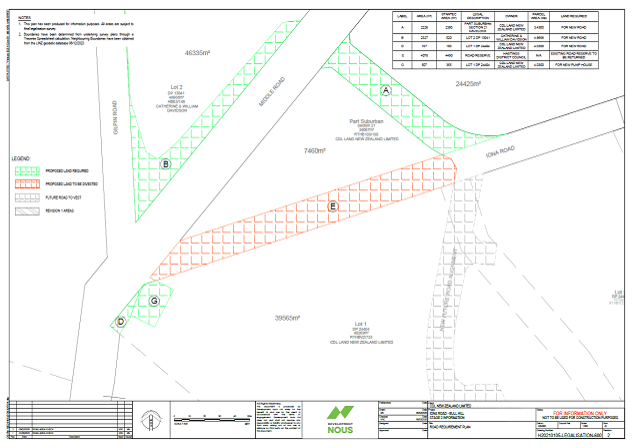
Figure 1 : Proposed Iona Structure Plan
3.4 Importantly,
the road stopping of that portion of Iona Road (Area E) is necessary to effect
the requirements of the Iona Structure Plan at its southern end. Given
the extensive consultation and Hearings process undertaken for the Iona
Structure Plan, the proposed road stopping may reasonably be regarded as an
inevitable outcome of that process. However, to effect it, Council does need to
go through the road stopping process as required under the Local Government Act
1974 hence this report.
3.5 Discussions
have been undertaken with CDL, the owners of the adjacent land, and they are
supportive of the southern section of Iona Road (Area E) being stopped.
CDL are also agreeable that the portion of land to be stopped would be swapped
for that portion of land required to provide the new link road to Middle Road
(Area A).
4.0 Discussion – Te Matapakitanga
4.1 The
stopping of roads and public accessways is detailed in the Local Government Act
1974, Section 319, Schedule 10. In summary:
· A
plan of the proposed stoppage shall be lodged with the office of the Chief
Surveyor.
· Council
shall give public notice of the proposed stoppage, calling for objections, for
a period of at least 40 days.
· If
no objections are received Council may declare the road stopped.
· If
any objections are received Council may either allow the objections or send the
case to the Environment Court.
4.2 If
the road stopping is successful, Council will then work with CDL to effect the
necessary land transfers to accommodate the realignment of Iona Road as
required by the Iona Structure Plan.
5.0 Options – Ngā Kōwhiringa
Option One - Recommended Option -
Te Kōwhiringa Tuatahi – Te Kōwhiringa Tūtohunga
5.1 Council
resolve to initiate the road stopping process to amalgamate the stopped road
with the CDL land.
Advantages
· Meets
the requirements of the Iona Structure Plan with the Iona Road realignment.
Disadvantages
· There
are no identified disadvantages with the proposal for stopping that part of
Iona Road as identified in the Iona Structure Plan.
Option Two – Status Quo - Te Kōwhiringa Tuarua – Te
Āhuatanga o nāianei
5.2 Council
resolve not to initiate to road stopping process to effect the land transfer:
Advantages
· There
are no identified advantages with the proposal for not stopping that part of
Iona Road as identified in the Iona Structure Plan.
Disadvantages
· It
would not enable the Iona Road realignment and is contrary to the Iona
Structure Plan requirements.
6.0 Next steps – Te Anga Whakamua
6.1 If
Council agrees to initiate the road stoppage and notifying the public, the
public will be given at least 40 days to raise objections.
6.2 Public
notices will include:
· Notice
on Council’s website.
· Two
notices in the local newspaper.
6.3 Council
will then need to consider any objections received and decide whether to
proceed with the road stoppage or not:
· If
no objections are received Council may declare the road stopped.
· If
any objections are received Council may either allow the objections or send the
case to the Environment Court.
6.4 If
Council agrees to stop the road, Council will then effect the road stopping and
associated land swap with CDL with both parties arranging for the legalisation.
Attachments:
|
1⇩
|
Iona Middle Land Requirement Plan
|
CG-17-1-01666
|
|
|
Summary of
Considerations - He Whakarāpopoto Whakaarohanga
|
|
Fit
with purpose of Local Government - E noho hāngai pū ai ki te
Rangatōpū-ā-Rohe
The Council is required to give effect to the purpose of
local government as set out in section 10 of the Local Government Act 2002.
That purpose is to enable democratic local decision-making and action by (and
on behalf of) communities, and to promote the social, economic, environmental,
and cultural wellbeing of communities in the present and for the future.
Link to the
Council’s Community Outcomes –
Ngā Hononga ki Ngā Putanga ā-Hapori
This proposal promotes the social
wellbeing of communities in the present and for the future in that it retains
the ability of safe public access on the roading network within the Iona
Structure Plan development.
|
|
Māori
Impact Statement -
Te Tauākī Kaupapa Māori
No specific impact on Māori.
|
|
Sustainability
- Te
Toitūtanga
N/A
|
|
Financial
considerations -
Ngā Whakaarohanga Ahumoni
All costs associated with the road
stopping will be shared with CDL as part of the Iona and Middle Road upgrade
and development.
|
|
Significance
and Engagement -
Te Hiranga me te Tūhonotanga
This decision/report has been assessed under the Council's
Significance and Engagement Policy as being of low significance.
|
|
Consultation
– internal and/or external - Whakawhiti Whakaaro-ā-roto / ā-waho
Consultation to be undertaken in
accordance with the process for Stopping of Roads as defined in the Local
Government Act 1974.
|
|
Risks
|
REWARD – Te Utu
|
RISK – Te Tūraru
|
|
The transfer of land would enable the Iona Structure
Plan to be realised with safer intersections on Middle Road at Iona Road
and Gilpin Road.
|
Requirement to take any objections to the Environment
Court but noting that the Iona Structure Plan had been consulted on and was
subsequently approved through the Environment Court and adopted by Council
with that including the realignment of Iona Road.
|
|
|
Rural
Community Board –
Te Poari Tuawhenua-ā-Hapori
N/A
|
|
Item 7 Road
Stopping of Part of Iona Road for the Iona Structure Plan
|
|
Iona
Middle Land Requirement Plan
|
Attachment 1
|

Te
Hui o Te Kaunihera ā-Rohe o Heretaunga
Hastings
District Council: Council Meeting
Te
Rārangi Take
Report to Council
|
Nā:
From:
|
Bruce Conaghan,
Transportation Policy and Planning Manager
|
|
Te Take:
Subject:
|
Authorisation for
relocation of a crossing place on a Limited Access Road to serve Lots 2-5 DP
508218 at 1275 Maraekakaho Road
|
1.0 Executive Summary – Te Kaupapa Me Te Whakarāpopototanga
1.1 This
Report recommends Council authorise the relocation of a crossing place on a
Limited Access Road to serve Lots 2-5 DP 508218 at 1275 Maraekakaho Road.
1.2 To
support a request for a new crossing place or the relocation of a crossing
place, Council needs to be satisfied that these do not have an impact on the
safety and operational efficiency of the Limited Access Road.
Consequently, the owner at 1275 Maraekakaho Road engaged Urban Connection to
provide a traffic and safety assessment to justify the proposed relocation of
crossing place (CP 102) at 1275 Maraekakaho Road.
1.3 Based
on the assessment by Urban Connection, it was found that relocating the
crossing place (CP 102) would not impact on the operational and safety
efficiency of Maraekakaho Road at this location and would work to improve
it.
1.4 Council
officers support the proposed relocation and therefore recommend that the
crossing place (CP 102) to Lots 2-5 DP 508218 at 1275 Maraekakaho Road be moved
north so that it is 114 to 126 metres south of the northern boundary of the
property (as shown in Attachment 1) be authorised by Council.
1.5 With
Maraekakaho Road from York Road to the State Highway 2 (SH2) Expressway being a
Limited Access Road, the relocation of a crossing place providing access, in
this case to Lots 2-5 DP 508218 at 1275 Maraekakaho Road, will need to be
authorised by Council. Accordingly, pursuant to Section 346 of the
Local Government Act 1974, it is recommended Council authorise the relocation
of crossing place CP102 to Lots 2-5 DP 508218 at 1275 Maraekakaho Road as shown
in Attachment 1.
|
2.0 Recommendations - Ngā Tūtohunga
A) That
Council receive the report titled Authorisation for relocation of a crossing
place on a Limited Access Road to serve Lots 2-5 DP 508218 at 1275
Maraekakaho Road dated 22 July 2025.
B) That
pursuant to Section 346 of the Local Government Act 1974, Council authorise
the relocation of a crossing place (CP 102) to Lots 2-5 DP 508218 at 1275
Maraekakaho Road to be 114 to 126 metres south of the northern boundary of
the property as shown in Attachment 1.
|
3.0 Background – Te Horopaki
3.1 In
June 2013, Council resolved to accept the control and management of relevant
sections of SH50A revoked by the New Zealand Transport Agency (NZTA), with
those sections being York Road from the Hawkes Bay Expressway to Maraekakaho
Road and Maraekakaho Road from York Road to Longlands Road, with the completion
of the southern extension of the Hawkes Bay Expressway. Both sections of
road had been declared as Limited Access Roads by NZTA.
3.2 Under
Section 96(1) of the Government Roading Powers Act 1989, any Limited Access
Road which is a State Highway and ceases to be a State Highway, shall be deemed
to be a Limited Access Road under the Local Government Act 1974 and the
administration of that road shall pass to the territorial authority responsible
for the control of roads in the district. Hence, York Road from the
Hawkes Bay Expressway to Maraekakaho Road and Maraekakaho Road from York Road
to Longlands Road maintain their status as Limited Access Roads.
3.3 Council
can authorise crossing places and construct any roads to give access to land
adjoining a Limited Access Roads in accordance with Section 346 of the Local
Government Act 1974. Given that crossing places on Limited Access Roads are
defined legally as part of the Limited Access Road Declaration, any request
relating to installing, relocating or removing crossing places therefore
requires the authorisation by Council.
3.4 The
owner of 1275 Maraekakaho Road has approached Council to relocate one of the
crossing places (CP 102) serving their property. The site at 1275
Maraekakaho Road has a designated crossing place (CP 102) located 211 to 215
metres south of the northern boundary of the site and the request is to
relocate some 93 metres north. Figure 1 below (and included as Attachment
1) shows the location of the existing crossing places at 1275 Maraekakaho Road
and the location of the relocated crossing place.

Figure 1 : Location of Crossing Places CP 102 and CP
103 at 1275 Maraekakaho Road
3.5 To
support a request for a new crossing place or the relocation of a crossing
place, Council needs to be satisfied that these do not have an impact on the
safety and operational efficiency of the Limited Access Road.
Consequently, the owner at 1275 Maraekakaho Road engaged Urban Connection to
provide a traffic and safety assessment to provide justification for the
proposed relocation of a crossing place (CP 102) at 1275 Maraekakaho Road.
4.0 Discussion – Te Matapakitanga
4.1 From
the assessment undertaken by Urban Connection, the existing crossing place (CP
102) is located in close proximity to another crossing place (CP 103) which
creates potential safety issues as noted below:
· Closely
spaced access points (driveways or intersections) can create uncertainty about
which location a vehicle wishes to turn into. A vehicle indicating to
turn into the southern crossing point (CP 103) could be mistaken as turning
into the northern crossing point (CP 102) meaning a vehicle turning right from
the southern crossing point could misjudge a vehicle’s intent resulting
in a side impact crash.
· A
comparable safety risk applies to left turning vehicles where a vehicle
indicating a left turn into the northern crossing point may be confused with
making a turn into the southern crossing point. In such cases, a vehicle
turning from CP 103 may misjudge the intent and proceed to turn right resulting
in a side impact crash.
· Vehicles
exiting one crossing place may have limited visibility due to a turning vehicle
at another located in close proximity. The most significant visibility
restriction in this case relates to a vehicle exiting the northern crossing
point having its sight distance to the south masked by a vehicle waiting to
turn right out of the southern crossing point. This situation has
the potential to increase the risk for side impact crashes.
· From
a safety perspective, increased separation between places of conflict is
beneficial in maintaining safety on the network.
4.2 Given
that the current location of northern crossing place( CP 102) being some 28
metres from the southern crossing place (CP 103) presents road safety issues as
noted above, there is merit in increasing separation between crossing
places. The proposed relocation of the northern crossing place (CP
102) some 93 metres to the north provides to increase that separation between
the crossing places and would improve safety and efficiency especially with any
future development of the site. This would then mean that the relocated
crossing place would be located 114 to 126 metres south of the northern
boundary of the property as shown in Attachment 1.
4.3 Based
on the assessment by Urban Connection, it was found that relocating the
crossing place (CP 102) would not impact on the operational and safety
efficiency of Maraekakaho Road at this location and would work to improve
it. Council officers support the proposed relocation and therefore
recommend that the crossing place (CP 102) to Lots 2-5 DP 508218 at 1275
Maraekakaho Road be moved north so that it is 114 to 126 metres south of the
northern boundary of the property (as shown in Attachment 1), be authorised.
4.4 With
Maraekakaho Road from York Road to the State Highway 2 (SH2) Expressway being a
Limited Access Road, the relocation of a crossing place providing access to
adjacent properties, and in this case to Lots 2-5 DP 508218 at 1275 Maraekakaho
Road, will need to be authorised by Council.
5.0 Options – Ngā Kōwhiringa
Option One - Recommended Option -
Te Kōwhiringa Tuatahi – Te Kōwhiringa Tūtohunga
5.1 That
Council authorise the relocation of a crossing place (CP 102) to Lots 2-5 DP
508218 at 1275 Maraekakaho Road.
Advantages
· It
would provide for operational and safety efficiency on Maraekakaho Road in this
vicinity and provide an access location which would better serve the site for
future development.
Disadvantages
· There
are no perceived disadvantages with this option.
Option Two – Status Quo - Te Kōwhiringa Tuarua – Te
Āhuatanga o nāianei
5.2 That
Council does not authorise the relocation of a crossing place (CP 102) to Lots
2-5 DP 508218 at 1275 Maraekakaho Road.
Advantages
· There
are no perceived advantages.
Disadvantages
· It
could create operational and safety issues on Maraekakaho Road in this vicinity
given another crossing place in close proximity.
6.0 Next steps – Te Anga Whakamua
6.1 If
the relocation of the crossing place (CP 102) to Lots 2-5 DP508218 at 1275
Maraekakaho Road is authorised by Council, the property owner would be
responsible for all costs associated with effecting legalisation of the
additional crossing place on the property title.
Attachments:
|
1⇩
|
1275 Maraekakaho Road Crossing Point
|
25/258
|
|
|
Summary of
Considerations - He Whakarāpopoto Whakaarohanga
|
|
Fit
with purpose of Local Government - E noho hāngai pū ai ki te
Rangatōpū-ā-Rohe
The Council is required to give effect to the purpose of
local government as set out in section 10 of the Local Government Act 2002.
That purpose is to enable democratic local decision-making and action by (and
on behalf of) communities, and to promote the social, economic,
environmental, and cultural wellbeing of communities in the present and for
the future.
Link to the
Council’s Community Outcomes –
Ngā Hononga ki Ngā Putanga ā-Hapori
This proposal promotes the wellbeing of
communities in the present and for the future.
|
|
Māori
Impact Statement -
Te Tauākī Kaupapa Māori
No specific implications for Māori.
|
|
Sustainability
- Te
Toitūtanga
N/A
|
|
Financial
considerations -
Ngā Whakaarohanga Ahumoni
If the relocation of the crossing
place (CP 102) is authorised, there is no cost to Council as all costs for
the legalisation of the relocation would be borne by the property owner of Lots
2-5 DP 508218 at 1275 Maraekakaho Road.
|
|
Significance
and Engagement -
Te Hiranga me te Tūhonotanga
This decision/report has been assessed under the Council's
Significance and Engagement Policy as being of low significance.
|
|
Consultation
– internal and/or external - Whakawhiti Whakaaro-ā-roto / ā-waho
Given that this is an administrative
matter between Council and the property owner, no consultation is required.
|
|
Risks
|
REWARD – Te Utu
|
RISK – Te Tūraru
|
|
The relocated crossing place (CP 102) for Lots 2-5 DP
508218 at 1275 Maraekakaho Road authorised pursuant to Section 346 of the
Local Government Act 1974 would provide for safety and efficiency on
Maraekakaho Road at this location.
|
There are no risks.
|
|
|
Rural
Community Board –
Te Poari Tuawhenua-ā-Hapori
There are no implications for the Rural
Community Board.
|
|
Item 8 Authorisation
for relocation of a crossing place on a Limited Access Road to serve Lots 2-5
DP 508218 at 1275 Maraekakaho Road
|
|
1275
Maraekakaho Road Crossing Point
|
Attachment 1
|

Hastings
District Council: Council Meeting
Te Rārangi Take
Report to Council
|
Nā:
From:
|
Louise Stettner,
Manager, Democracy & Governance Services
|
|
Te Take:
Subject:
|
Proposed Amendments To
Schedule Of Meetings
|
1.0 Purpose and summary - Te Kaupapa Me Te Whakarāpopototanga
1.1 The
purpose of this Report is to consider amendments to the schedule of Council and
Committee Meetings for the 2024 Meetings Calendar which was adopted by Council on
7 November 2024.
1.2 The
Local Government Act 2002, Schedule 7, Clause 19 states:
“A
local authority must hold meetings at the times and places that it
appoints”.
If a local authority adopts a schedule of meetings-
a) The schedule-
i) may cover
any future period that the local authority considers appropriate, and
ii) may be amended.
Although a local authority must hold the ordinary meetings
appointed, it is competent for the authority at a meeting to amend the schedule
of dates, times and number of meetings to enable the business of the Council to
be managed in an effective way.
1.3 It is
proposed that the meeting schedule be amended as outlined in the
Recommendations of this Report.
|
2.0 Recommendations -
Ngā Tūtohunga
A) That Council
receive the report titled Proposed Amendments To Schedule Of Meetings dated 22
July 2025.
B) That Council
adopt changes to the 2025 Schedule of Meetings as follows:
|
Wednesday,
13 August 2025 at 1.00pm
Council
Chamber
|
New
meeting
|
District
Planning & Bylaws Subcommittee
|
|
Wednesday,
16 July – moved to
Monday,
18 August at 10.30am
Council Chamber
|
Postponement
|
HDC: Tangata Whenua
Waste Joint Committee
|
|
Attachments:
There are no attachments for this report.

Hastings
District Council: Council Meeting
Te Rārangi Take
Report to Council
|
Nā:
From:
|
Rebecca Hill, Senior
Environmental Planner - Policy
|
|
Te Take:
Subject:
|
Submissions on Proposed
National Policy Statements and National Environmental Standards Changes and
on the Freshwater Discussion Document
|
1.0 Executive Summary
– Te Kaupapa Me Te
Whakarāpopototanga
1.1 This
Report relates to submissions prepared by Officers on proposed changes to
National Policy Statements, National Environmental Standards under the Resource
Management Act, and on a discussion document on Freshwater that will inform
resource management reform.
1.2 The
purpose of this Report is to inform the Council of the submissions and seek the
endorsement of the submissions on the proposed National Direction
changes. The changes proposed are wide ranging and the issues traversed
are of importance to the Hastings District.
|
2.0 Recommendations -
Ngā Tūtohunga
A) That Council
receive the report titled Submissions on Proposed National Policy Statements
and National Environmental Standards Changes and on the Freshwater Discussion
Document dated 22 July 2025.
B) That Council
notes and endorses the submissions on the following National Direction
instruments and discussion document.
i. National
Policy Statement – Infrastructure (NPS-I)
ii. National
Policy Statement – Natural Hazards (NPS-NH)
iii. National
Environmental Standards – Granny Flats (Minor Residential Units)
(NES-MRU)
iv. National
Environmental Standards – Papakāinga (NES-P)
v. National
Policy Statement – Renewable Electricity Generation (NPS-REG)
vi. National
Policy Statement – Electricity Networks (NPS-EN)
vii. National
Environmental Standards – Electricity Network Activities (NES-ENA)
viii. National
Environmental Standards – Telecommunication Facilities (NES-TF)
ix. National
Policy Statement – Highly Productive Land (NPS-HPL)
x. Package
3 - Freshwater
|
3.0 Background
– Te Horopaki
3.1 The
Government is seeking feedback on four consultation packages of National
Direction. The consultation for the first three packages will run until Sunday
27 July and until 17 August for Package 4. This is likely the only
opportunity to submit on Packages 1 and 2. Packages 3 and 4 are
discussion documents inviting feedback on how Freshwater and Going for Housing
Growth are managed under the new resource management legislation and therefore
there will be further opportunities to submit.
3.2 The
changes proposed in Packages 1 and 2 will not require immediate changes to
District Plans as the Government is looking for “quick wins” prior
to Phase 3 reform being the repeal and replacement of the Resource Management Act
(RMA). These National Direction changes will however impact District Plan
Changes (including private plan changes) which must give effect to National
Direction and consenting decisions which must have regard to National
Direction.
3.3 Following
the consultation period, Ministry staff will make recommendations to the
Minister, the Minister will make decisions and then changes to national
directions will likely take effect before the end of 2025 or early 2026.
3.4 Package 1:
Infrastructure and development
The Government
aims to make four new national direction instruments and amend four existing
national direction instruments that relate to infrastructure and
development.
· New
National Policy Statement for Infrastructure
· New
National Policy Statement for Natural Hazards
· New
National Environmental Standards for Granny Flats (Minor Residential Units)
· New
National Environmental Standards for Papakāinga
· Amendments
to the National Policy Statement for Renewable Electricity Generation
· Amendments
to the National Policy Statement for Electricity Networks
· Amendments
to the National Environmental Standards for Electricity Network Activities
· Amendments
to the National Environmental Standards for Telecommunication Facilities
3.5 Package 2: Primary
sector
The Government
aims to make changes to national direction instruments and change the quarrying
and mining provisions in national direction for freshwater, indigenous
biodiversity and highly productive land.
· Amendments
to the National Environmental Standards for Marine Aquaculture
· Amendments
to the National Environmental Standards for Commercial Forestry
· Amendments
to the New Zealand Coastal Policy Statement
· Amendments
to the National Policy Statement for Highly Productive Land
· Amendments
to the Stock Exclusion Regulations
· Amendments
to the mining and quarrying provisions in:
o National
Policy Statement for Indigenous Biodiversity
o National
Policy Statement for Highly Productive Land
o National
Policy Statement for Freshwater Management
o National
Environmental Standards for Freshwater.
3.6 Package
3: Freshwater
The Government
is seeking feedback on options to amend freshwater national direction and on whether
changes should be implemented under the existing RMA or under new resource
management legislation. Further consultation will be
undertaken, later this year, through a more detailed exposure draft of the
proposed freshwater national direction.
3.7 Package
4: Going for Housing Growth
The Government is
also seeking feedback on how the proposals in the first pillar of the Going for
Housing Growth programme could fit into the new resource management
system. Pillar 1 aims to free up land for development and remove
unnecessary planning barriers. This package will be the subject of a
subsequent report to Council.
4.0 Discussion
– Te
Matapakitanga
4.1 Package 1:
Infrastructure and Development
New National Policy Statement
for Infrastructure
This proposal
would see decision makers being required to recognise and provide for the
benefits of infrastructure and to recognise the functional and operational need
for infrastructure to be located in particular environments. NPS-I
contains policies on managing the interface between infrastructure and other
activities to protect infrastructure from reverse sensitivity effects. A
broader definition of infrastructure has been used and includes social
infrastructure e.g. schools, hospitals and parks. Infrastructure
supporting activities like quarrying are also included. The
proposed submission is in general support of the new NPS-I.
New National Policy Statement
for Natural Hazards
The NPS-NH
looks to imbed good practice around risk-based hazard assessment and
proportionate management of seven natural hazards; flooding, landslips, coastal
erosion, coastal inundation, active faults, liquefication, and tsunami.
When assessing natural hazards local authorities must consider; likelihood,
consequence, mitigation and residual risk. A matrix ranks likelihood and
consequence with medium, high or very high risk being deemed a
“significant hazard”. Development should be directed
away from areas of high or very high risk and enabled in areas of low risk.
The proposed
submission outlines our general support for National Direction for Natural
Hazards but outlines significant concerns that the matrix settings are too low
for hazards that have major and catastrophic consequences. The concern is
that these settings will undermine current hazard planning and the future
resilience of communities.
New National Environmental
Standards for Granny Flats (Minor Residential Units)
The Government
has committed to changing the Building Act 2004 to make it easier to build
minor residential units requiring only an engineer’s report. This
NES will allow these to be built without the need for a resource consent
subject to permitted activity standards including maximum floor area of 70m2.
The proposed
submission is in general support as our District Plan already provides of Minor
Residential Units. The submission points relate to concerns around
setbacks, vehicle access and natural hazards.
New National Environmental
Standards for Papakāinga
The proposed
NES-P is intended to enable papakāinga. The proposal permits
papakāinga development (up to 10 homes) on Māori land subject to a
set of standards. Certain non-residential activities are proposed to be
permitted, including: commercial activities (of up to 100 square metres) and
conservation activities, visitor accommodation for up to eight guests,
educational and health facilities, sports and recreation activities and marae,
urupā and māra kai. The proposal is for a resource consent
process for a restricted discretionary activity to apply to other, smaller
scale papakāinga that do not meet all the permitted activity standards,
have between 11 and 30 residential units or that are proposed to be located on
Treaty settlement land. The proposal is that a resource consent process for a
discretionary activity will apply to larger scale papakāinga developments
of more than 30 residential units.
The proposed
submission is in general support of the new NES-P, however a number of
submission points have been made on the assessment criteria and standards e.g.
setbacks.
Amendments to the National
Policy Statement for Renewable Electricity Generation
The key
proposed changes include; an objective that better recognises the critical role
REG plays in society and the economy and the rapid increase in REG required to
achieve climate emissions reductions, enabling and directive policies to better
enable REG and protect existing REG assets, direction on recognising and
providing for Māori interests, and policies to better enable REG while
managing effects on the environment.
The proposed
submission is in general support with submission points relating to the
protection of Māori interests and Section 6 matters.
Amendments to the National
Policy Statement for Electricity Networks
The proposal
will include: an amended objective to recognise and provide for the national
significance and benefits of the electricity network and electricity
distribution network, amended and new policies to support route selection and
manage environmental effects, a new policy to recognise and provide for tangata
whenua interests, policy amendments to provide greater protection of
electricity networks, updated references to the electric and magnetic fields
international guidelines (from the currently referenced 1998 guidelines to the
2010 guidelines), alignment of the policy directions of the NPS-EN and the
proposed National Environmental Standards for Electricity Network Activities
(NES-ENA).
The proposed
submission is in general support of the amended NPS-EN with submission points
on protecting Māori rights and interest and hazard resilience.
Amendments to the National
Environmental Standards for Electricity Network Activities
The proposed
amendments are intended to: enable more routine work on the electricity
transmission network in all environments, introduce new rules to protect the
electricity transmission network based on the National Grid Corridor
provisions, introduce new provisions for the electricity distribution network
(ie, protection and routine works for the existing network, and construction of
new distribution network assets), introduce new permitted activity standards
for EV charging infrastructure.
The proposed
submission is in general support with submission points on noise and height of
structures.
Amendments to the National
Environmental Standards for Telecommunication Facilities
The NES-TF
enables installation of facilities without the need for resource consent whilst
enabling local decision-making for environmentally significate areas e.g.
outstanding landscape areas. The key factors requiring these changes are;
changes in technology (e.g. bigger cabinets needed for more battery space for
emergency resilience) and changes in the built environment (higher buildings
means higher towers needed).
The proposed
submission is in general support with submission points relating to the height
of structures and temporary telecommunication facilities.
4.2 Package
2: Primary Sector
Amendments
to the National Environmental Standards for Marine Aquaculture
This proposal
makes it more enabling for replacement of structures, spat collection and
reconsenting. No submission is recommended as these matters fall within
the function of the regional council.
Amendments
to the National Environmental Standards for Commercial Forestry
This proposal
aims to create efficiencies in forestry operation and consent for example they
are asking for feedback on requiring slash mobilisation risk assessments and/or
requiring all slash above an identified size being removed from forest cutover.
No submission is recommended as these matters primarily fall within the
function of the regional council.
Amendments
to the New Zealand Coastal Policy Statement
The proposed
amendments are intended to: to better enable development of priority
activities, recognise that priority activities may have a functional or
operational need to be located in the coastal marine area, direct
decision-makers to provide for aquaculture activities within aquaculture
settlement areas, and give more recognition to the cultural and environmental
benefits of aquaculture. No submission is recommended as these matters
primarily fall within the function of the regional council.
Amendments
to the Stock Exclusion Regulations
The proposal is
to amend the requirement that all stock must be excluded from any natural
wetlands that support a population of threatened species, so that it would not
apply to non-intensively grazed beef cattle and deer. No submission is
recommended as these matters fall within the function of the regional council.
Amendments
to the mining and quarrying provisions in:
o National
Policy Statement for Indigenous Biodiversity
o National
Policy Statement for Highly Productive Land
o National
Policy Statement for Freshwater Management
o National
Environmental Standards for Freshwater.
These changes
are designed to be more enabling for mining and quarrying and to achieve
consistency across these instruments. No submission is recommended with
comments included in the submission on NPS-HPL regarding quarrying and mining.
Amendments
to the National Policy Statement for Highly Productive Land
The proposal is to amend
the NPS-HPL to provide more opportunities for urban development while retaining
the most agriculturally productive land for primary production.
The proposed amendments
involve:
• removing LUC 3 land
from NPS-HPL restrictions with immediate effect
• maintaining NPS-HPL
restrictions on LUC 1 and 2 land
• testing alternative
ways to continue to protect additional areas of agricultural land that are
important for food and fibre production, and consulting on establishing special
agriculture areas (SAAs) around key horticulture hubs like Pukekohe and
Horowhenua
• extending
timeframes for mapping of HPL to be completed within two to three years (2027
or 2028) or suspending requirements for mapping HPL until further direction is
provided in the replacement resource management system.
Feedback from Councillors
was sought to inform this submission which included maintaining restrictions on
LUC1 and LUC2 land and maintaining restrictions over LUC3 land or introducing
SAAs.
The proposed submission does
not support the total removal of LUC3 land from NPS-HPL as it is ineffective in
meeting the objective of enabling more opportunities for urban development
whilst removing protections for a high proportion of HPL.
The proposed submission
supports;
a. Retaining
LUC3 in NPS-HPL.
b. Introducing
Special Agricultural Areas with the Heretaunga Plains identified as a SAA.
c. Retaining
LUC3 in NPS-HPL but removing from urban rezoning decisions (Council led plan
changes only).
The proposed
submission does not support the deferment or suspension of mapping of HPL and
supports retaining the requirement for HPL to be mapped by Regional Councils.
4.3 Package 3:
Freshwater
The Government
is seeking feedback on options to amend freshwater national direction and on
whether changes should be implemented under the existing RMA or under new resource
management legislation.
Options to
amend freshwater instruments:
· Rebalancing
the NPS for Freshwater Management
o Make it clear
the freshwater management requires the balancing of multiple objectives, and
that councils need to consider the cost impacts of meeting freshwater targets,
and that long timeframes may be appropriate
o Rebalance Te
Mana o te Wai to reflect the importance of freshwater to all New Zealanders,
and
o Provide
flexibility for how councils manage and monitor freshwater under the National
Objectives Framework.
· Providing
for domestic supply of commercial vegetable growing and water security.
· Amending
activity-based controls in the NES for Freshwater:
o Make changes to
the requirements (including information requirements) under the synthetic
nitrogen fertiliser regulations, and
o Simplify the
definition and restrictions in relation to wetlands and requirements for fish
passage and culverts.
· Improving
the protection of drinking water sources through mapping requirements.
Further
consultation will be undertaken, later this year, through a more detailed
exposure draft of the proposed freshwater national direction. The
proposed submission focuses on the mapping requirements of drinking water
sources.
5.0 Options – Ngā Kōwhiringa
Option One - Recommended Option -
Te Kōwhiringa Tuatahi – Te Kōwhiringa Tūtohunga
5.1 Council notes the
following submissions and endorses them.
i) National
Policy Statement – Infrastructure (NPS-I)
ii) National Policy Statement
– Natural Hazards (NPS-NH)
iii) National Environmental
Standards – Granny Flats (Minor Residential Units) (NES-MRU)
iv) National Environmental
Standards – Papakāinga (NES-P)
v) National Policy Statement
– Renewable Electricity Generation (NPS-REG)
vi) National Policy Statement
– Electricity Networks (NPS-EN)
vii) National
Environmental Standards – Electricity Network Activities (NES-ENA)
viii) National
Environmental Standards – Telecommunication Facilities (NES-TF)
ix) National Policy Statement
– Highly Productive Land (NPS-HPL)
x) Package 3 - Freshwater
5.1.1 Advantages
· By
submitting on these National Direction changes, Council is actively
participating on issues that impact the District and can promote the interests
of the District.
· The submissions are based on the
expert advice of Council Officers.
5.1.2 Disadvantages
· There are no disadvantages identified.
Option Two – Status Quo - Te Kōwhiringa Tuarua
– Te Āhuatanga o nāianei
5.2 Make no submission to
the National Direction changes.
5.2.1 Advantages
· There are no advantages identified.
5.2.2 Disadvantages
· This option would see a lost
opportunity to influence national planning instruments.
6.0 Next steps – Te Anga Whakamua
6.1 The
submission will be sent to the Ministry for the Environment prior to 27 July.
6.2 A
further report by the Growth and Development Team will be bought to Council
with a submission on Package 4 Going for Housing Growth.
6.3 Council
Officers will continue to engage with the Ministries and will bring back
further opportunities to submit on resource management reform.
Attachments:
|
1⇩
|
Legislation, Bylaws & Standards - Acts & Statutes
- Resource Management Act - Amendments - National Direction Submission
Packages 1 2 & 3- July 2025
|
CG-17-1-01678
|
|
|
Item 10 Submissions
on Proposed National Policy Statements and National Environmental Standards
Changes and on the Freshwater Discussion Document
|
|
Legislation,
Bylaws & Standards - Acts & Statutes - Resource Management Act -
Amendments - National Direction Submission Packages 1 2 & 3- July 2025
|
Attachment 1
|
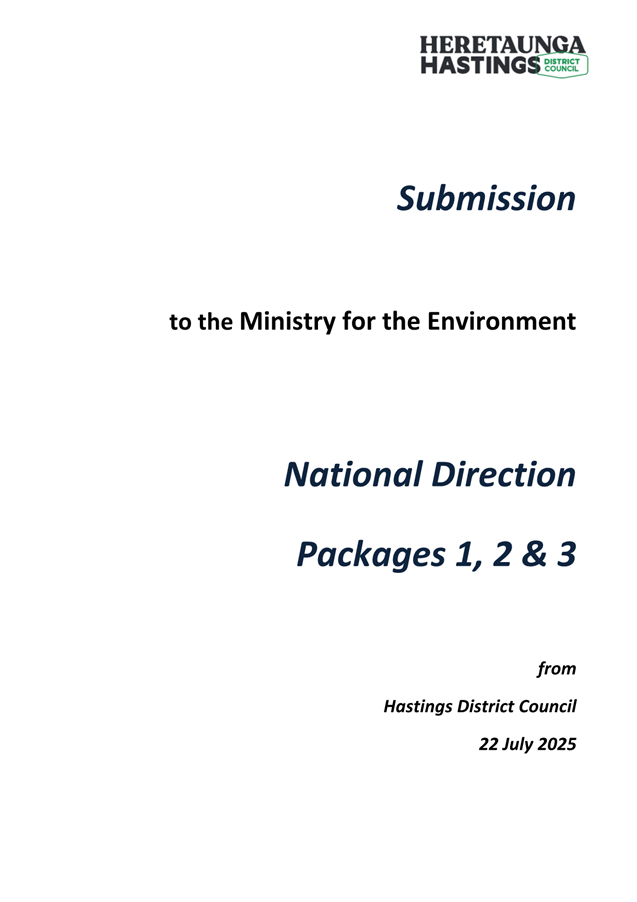
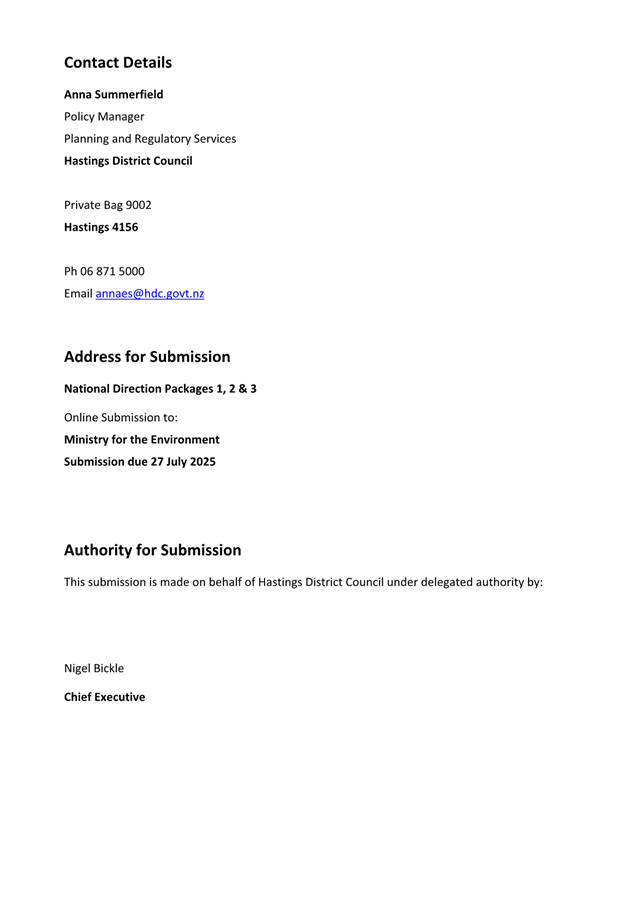
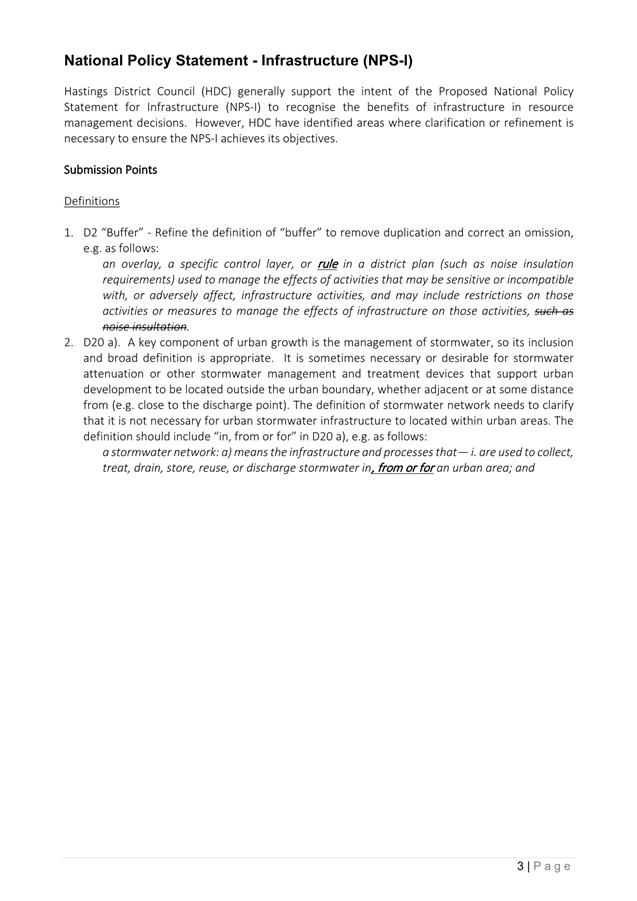
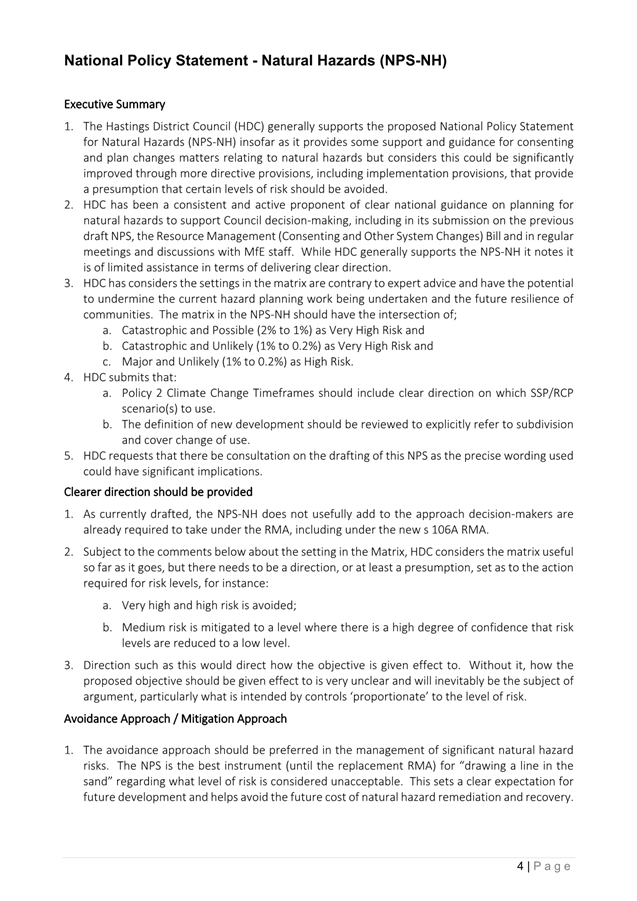
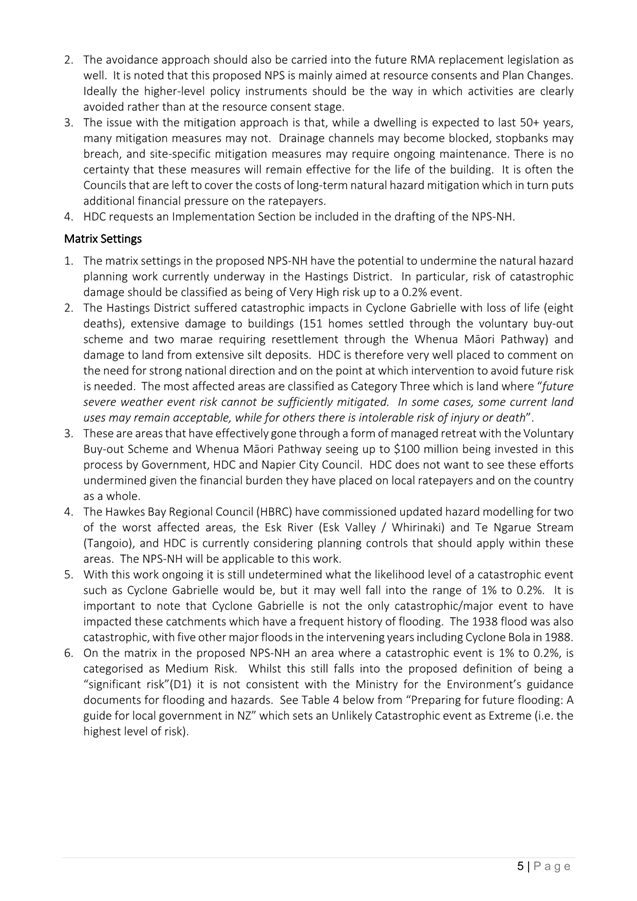
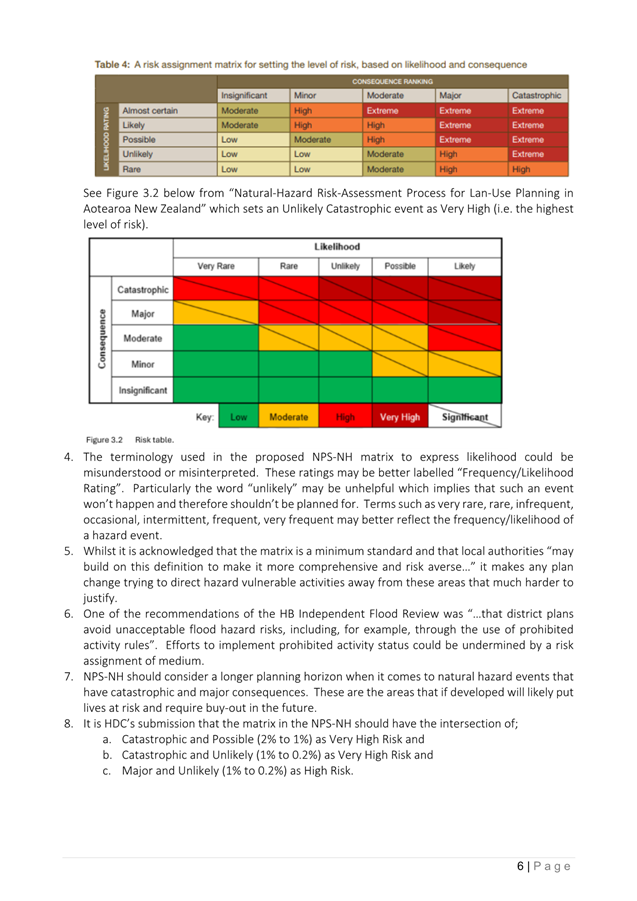
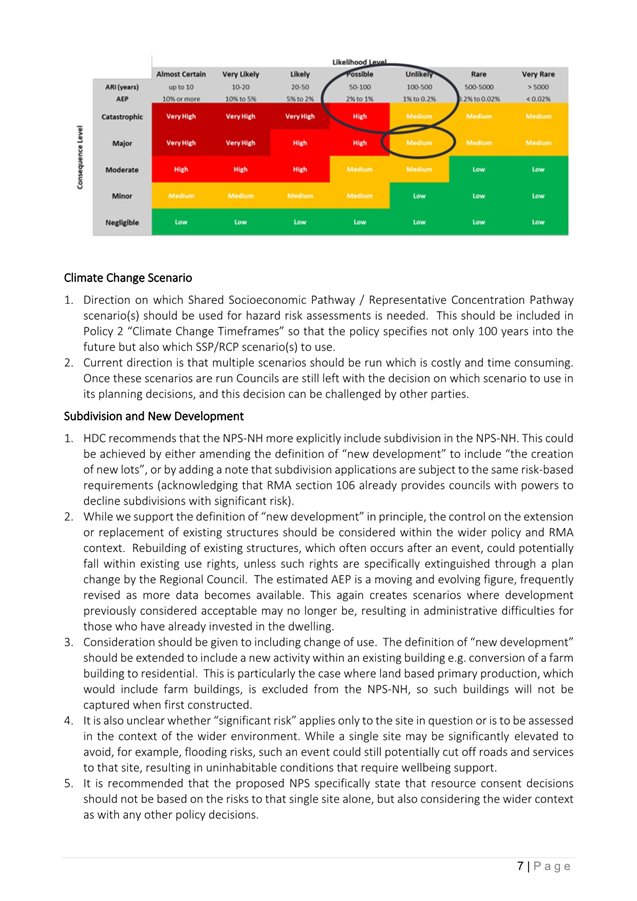
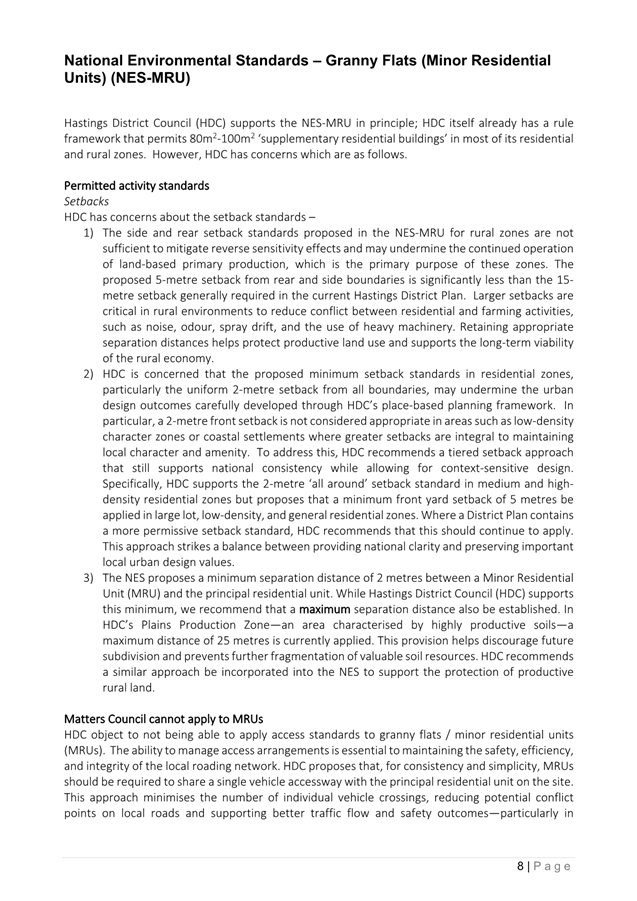
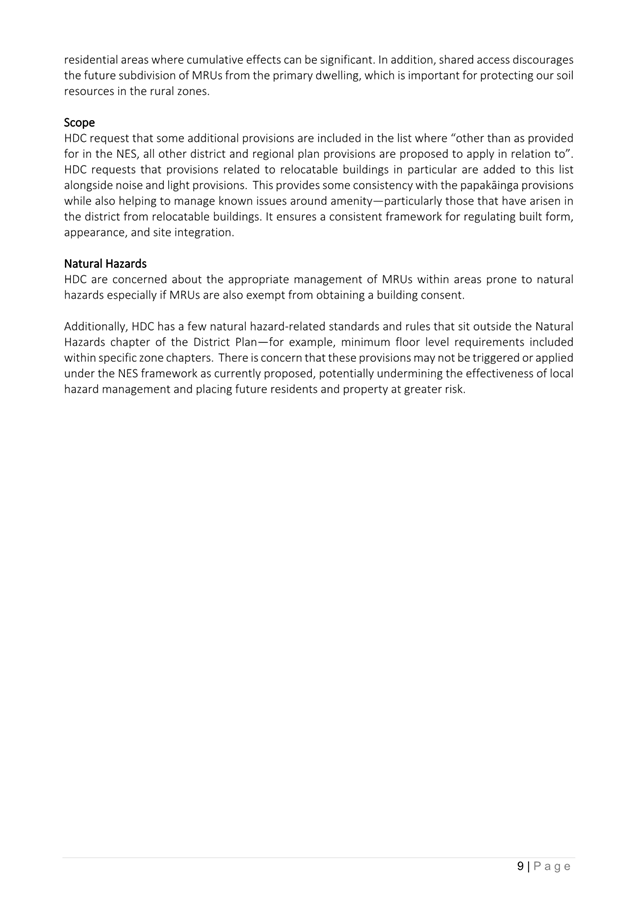
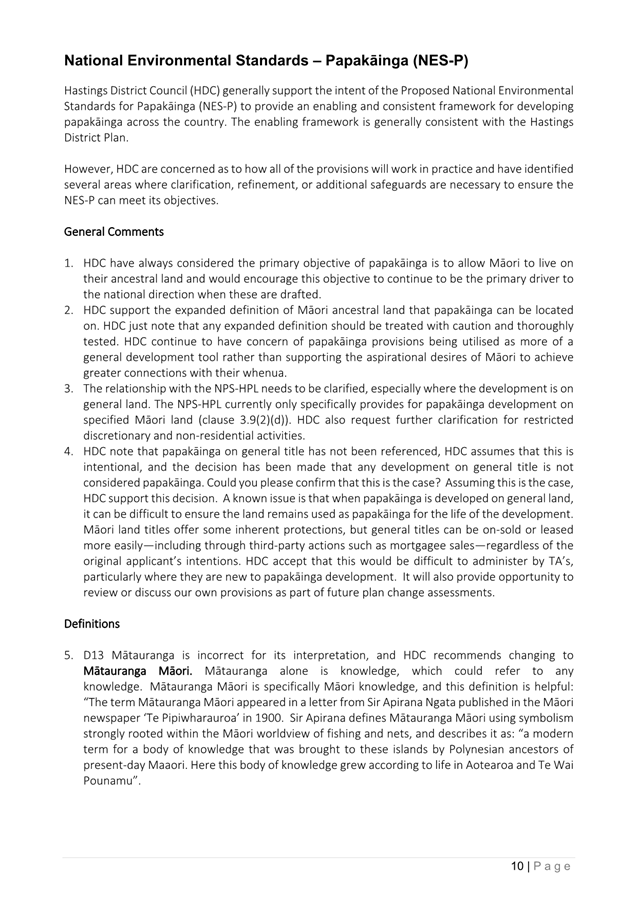
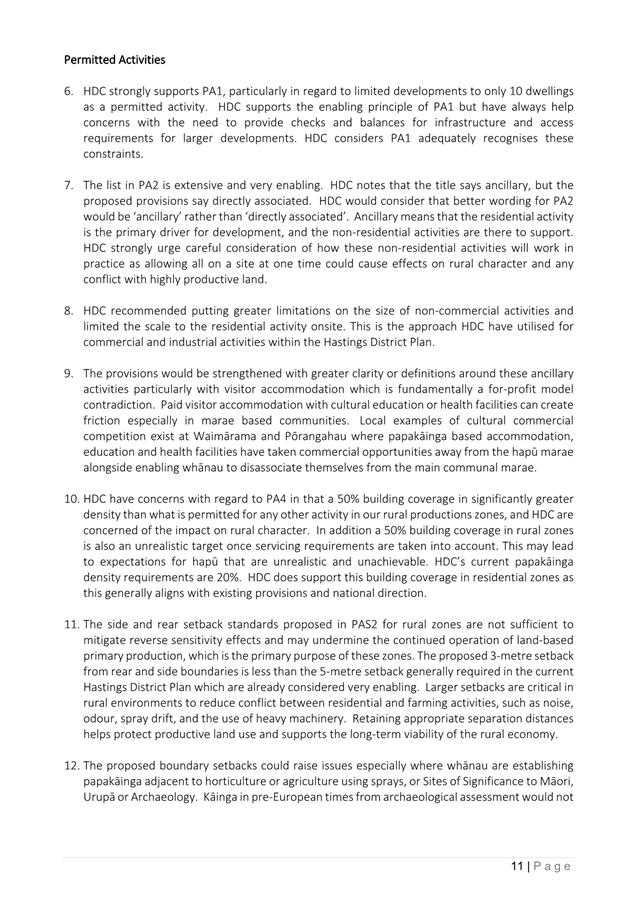
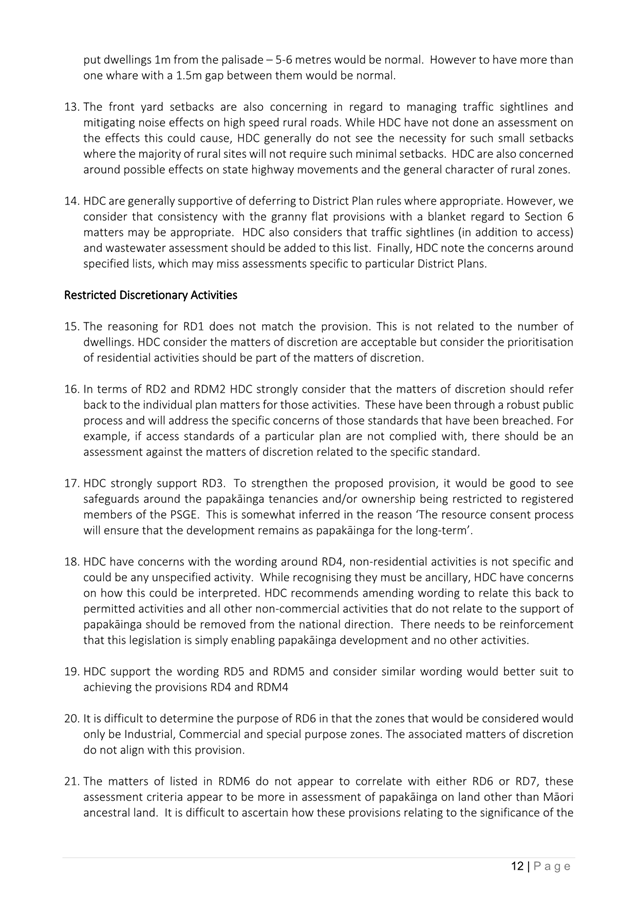
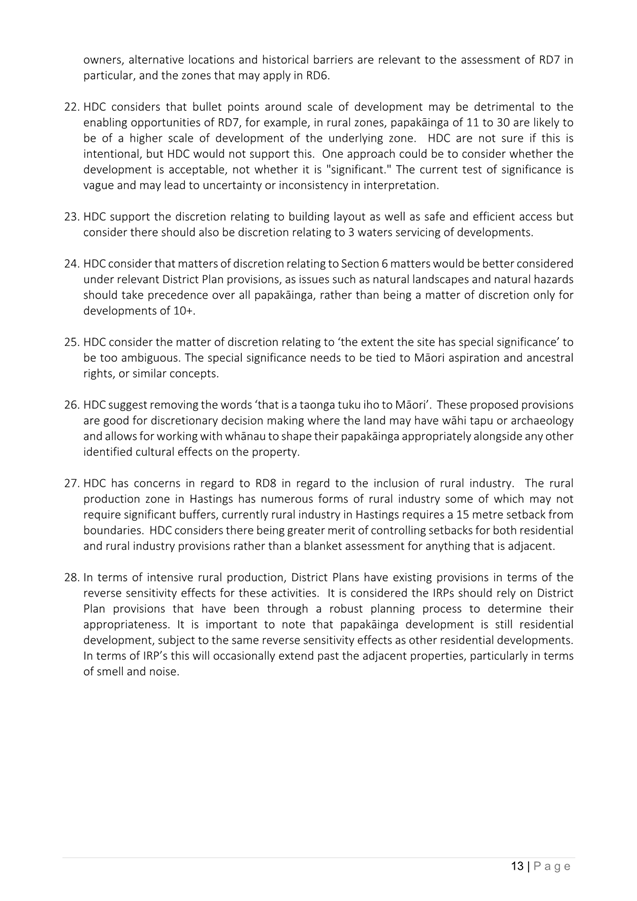
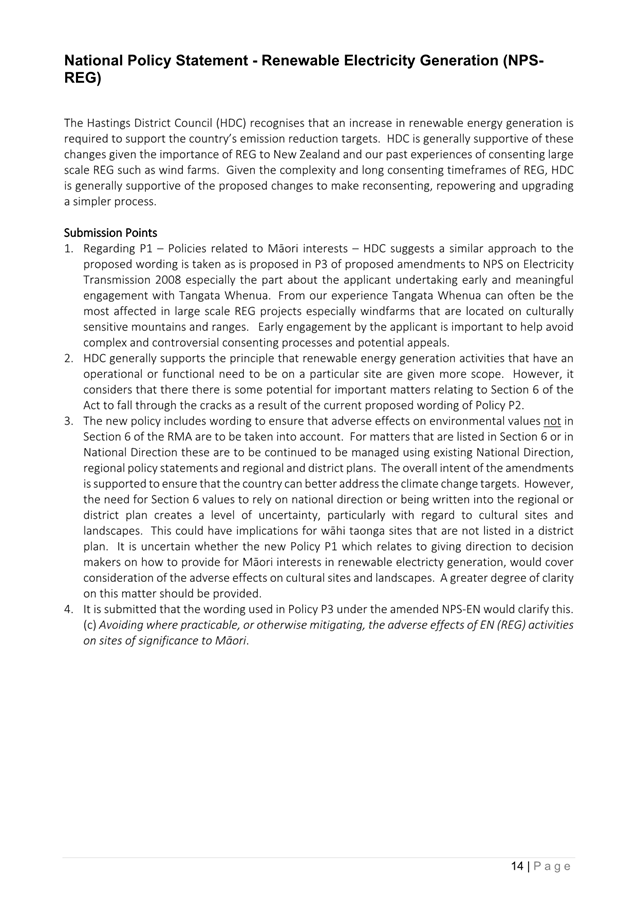
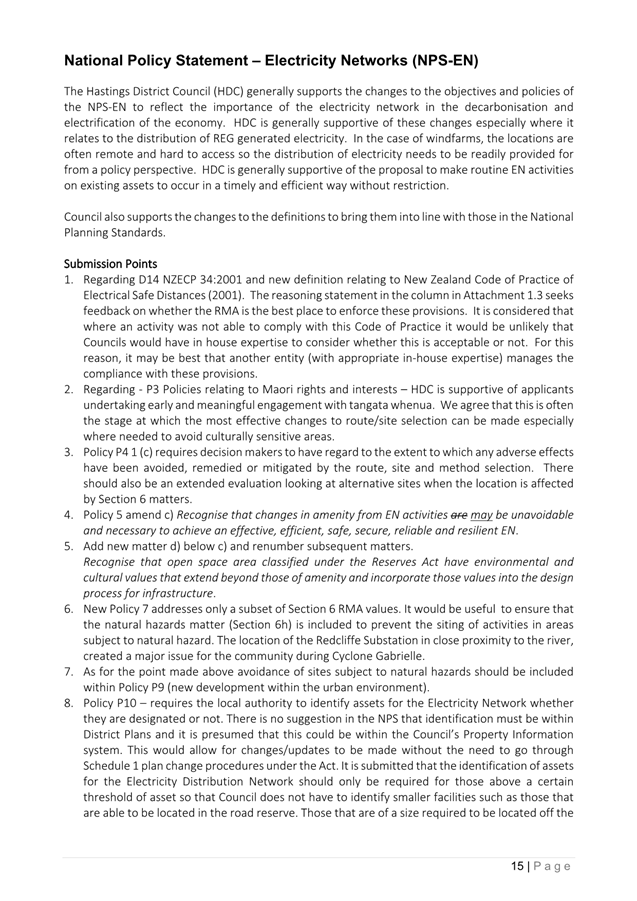

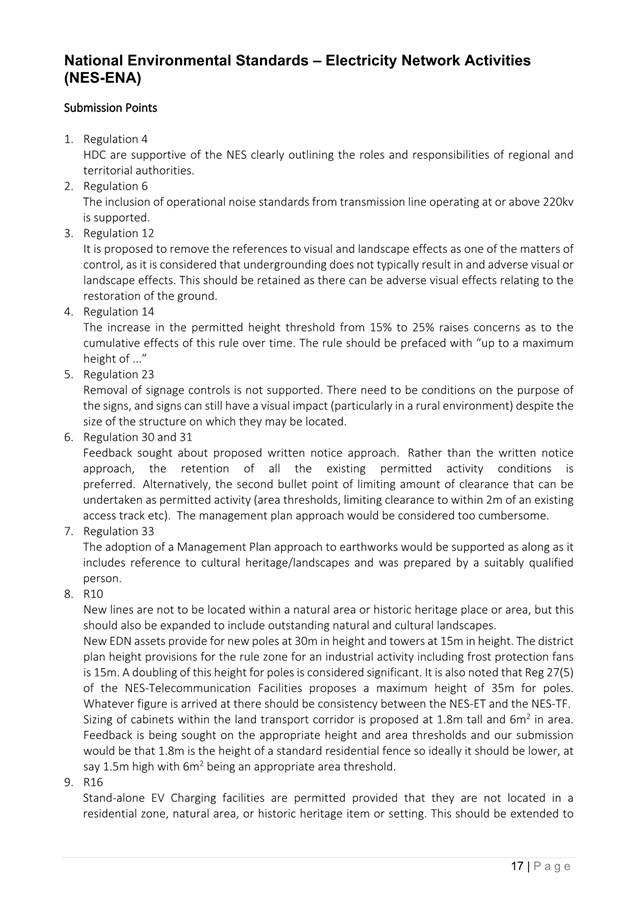



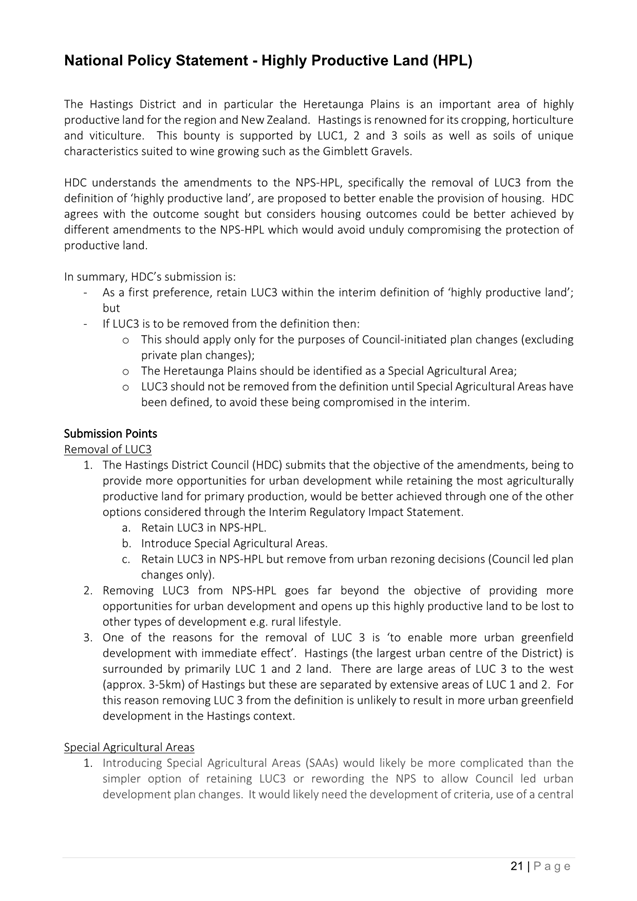
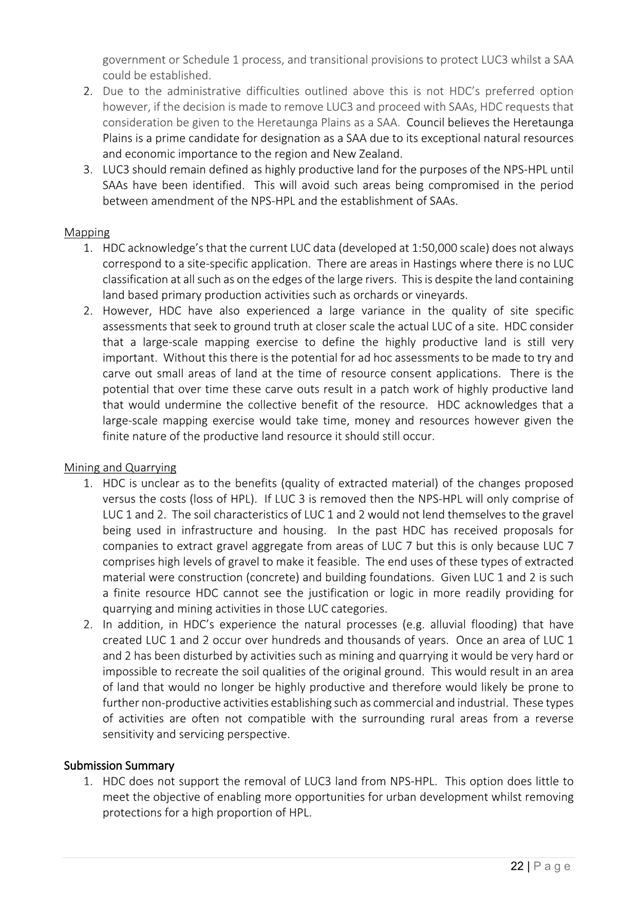


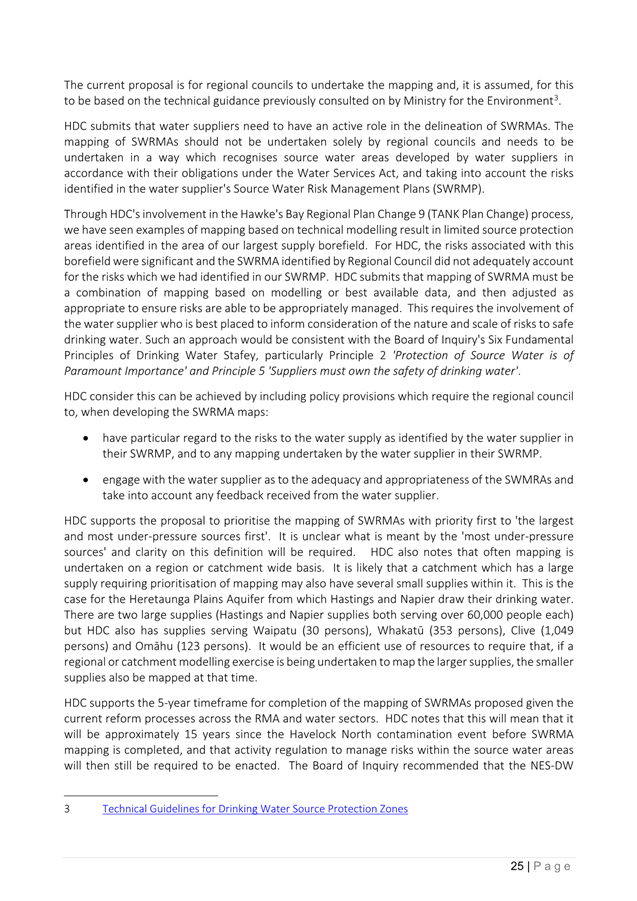
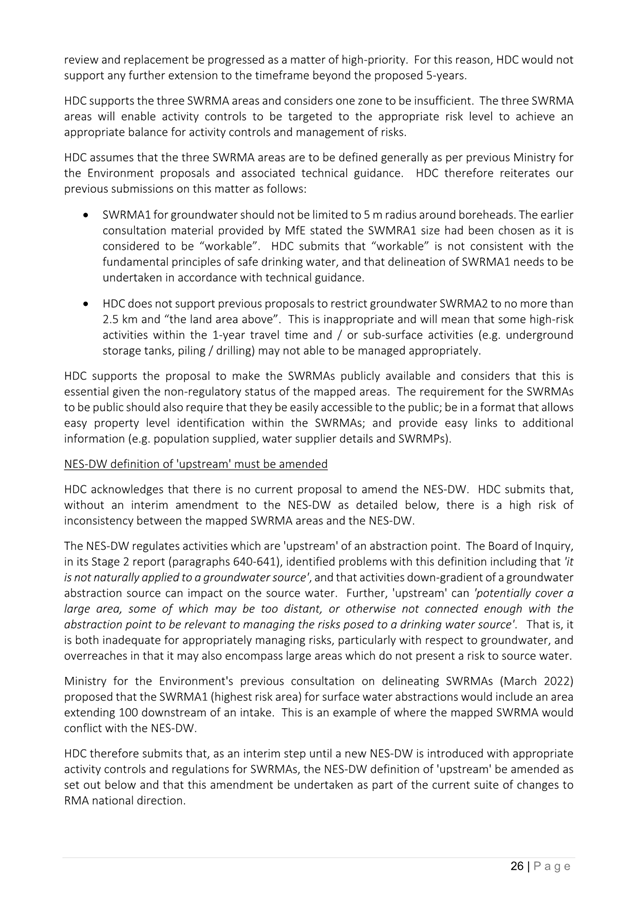
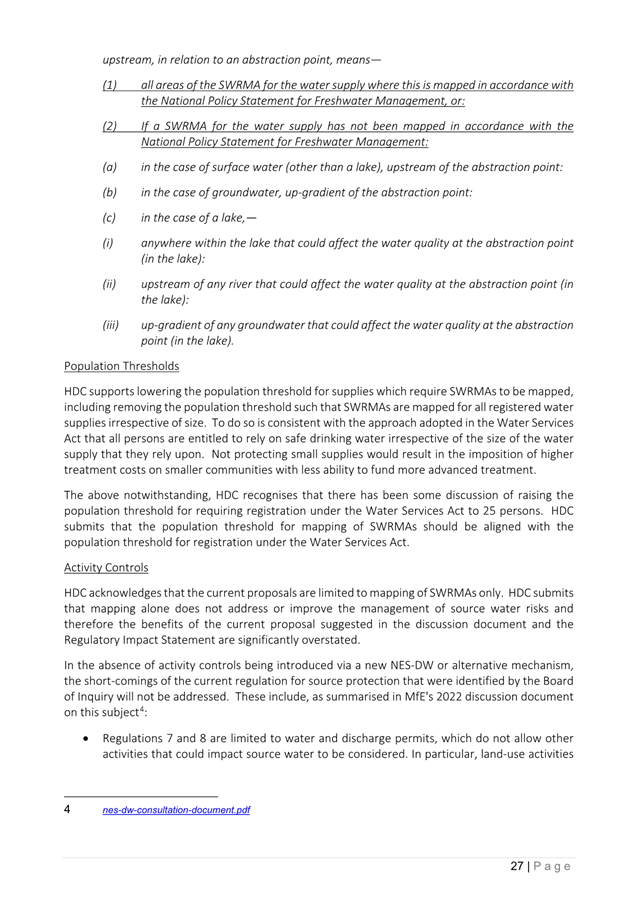
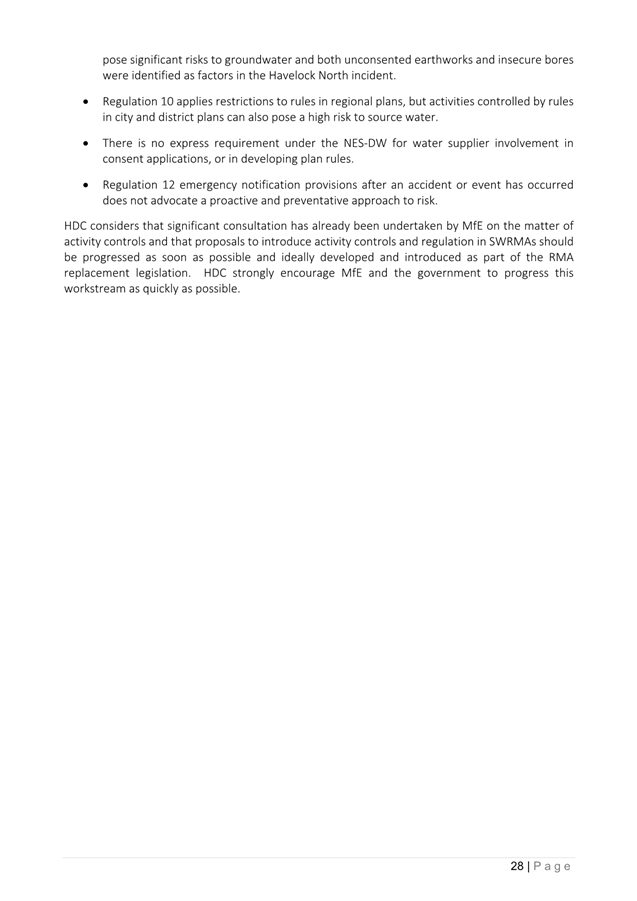
HASTINGS DISTRICT COUNCIL
Council MEETING
Tuesday, 22 July 2025
RECOMMENDATION TO EXCLUDE THE PUBLIC
SECTION 48, LOCAL GOVERNMENT OFFICIAL INFORMATION AND
MEETINGS ACT 1987
THAT the public now be excluded from the following part of
the meeting, namely:
14 CON2020007
- 3 Waters Maintenance Contract
The general subject of the matter to be considered while the
public is excluded, the reason for passing this Resolution in relation to the
matter and the specific grounds under Section 48 (1) of the Local Government
Official Information and Meetings Act 1987 for the passing of this Resolution
is as follows:
|
GENERAL SUBJECT OF
EACH MATTER TO BE CONSIDERED
|
REASON FOR PASSING
THIS RESOLUTION IN RELATION TO EACH MATTER, AND
PARTICULAR INTERESTS
PROTECTED
|
GROUND(S) UNDER
SECTION 48(1) FOR THE PASSING OF EACH RESOLUTION
|
|
|
|
|
|
14 CON2020007
- 3 Waters Maintenance Contract
|
Section 7 (2) (h)
The withholding of the
information is necessary to enable the local authority to carry out, without
prejudice or disadvantage, commercial activities.
This report contains
commercially sensitive information that relates to the potential negotiations
to the contract terms and conditions for the roll-over period.
|
Section 48(1)(a)(i)
Where the Local Authority is
named or specified in the First Schedule to this Act under Section 6 or 7
(except Section 7(2)(f)(i)) of this Act.
|

























